

Isopoda, Woodlice
There are many pictures on the site and there are two components: general en species
General:
In The Netherlands there are 37 species of which 8 exclusively in tropical greenhouses.
On the waarneming.nl forum I found
an article by David Tempelman, explaining the five most common species.
This short help made it possible for me to bring to a name three species,
which I had on the picture, and then, of course, the challenge to find other species.
A name list of the Dutch pill bugs by M.P Berg (Berg 1997) can be downloaded from the website of Naturalis (sorry Dutch)
pdf.
On the website www.pissebeddenproject.nl you can find a key (also Dutch)
(Berg, M.P. & Winhoven, H. 1997) (pdf)
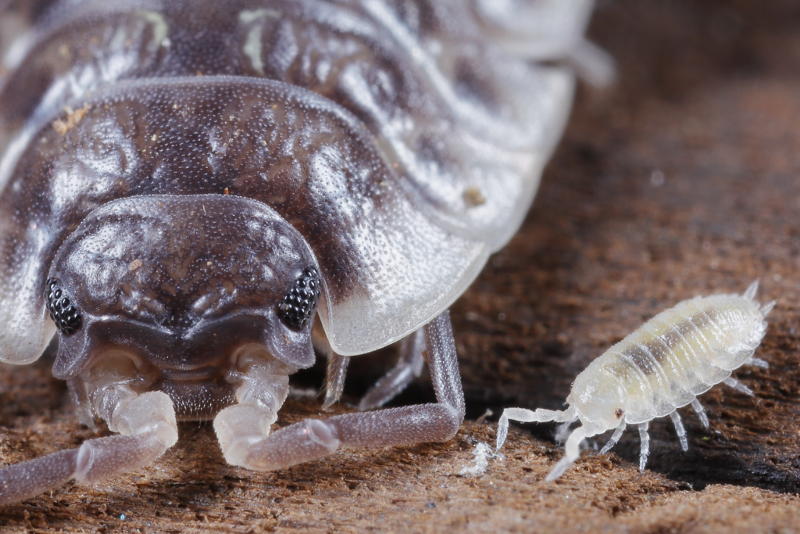
Common Woodlouse and manca
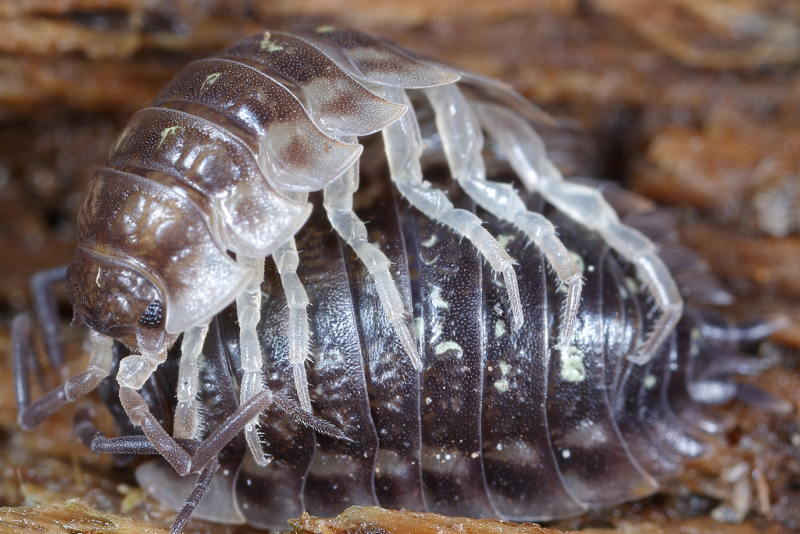
Common Woodlouse, mating
Woodlice are one of the few species of crustaceans that have adapted themselves to life on land. They are even independent of water puddles for the first stage. The females have a water-filled brood pouch in which the first stage developes.
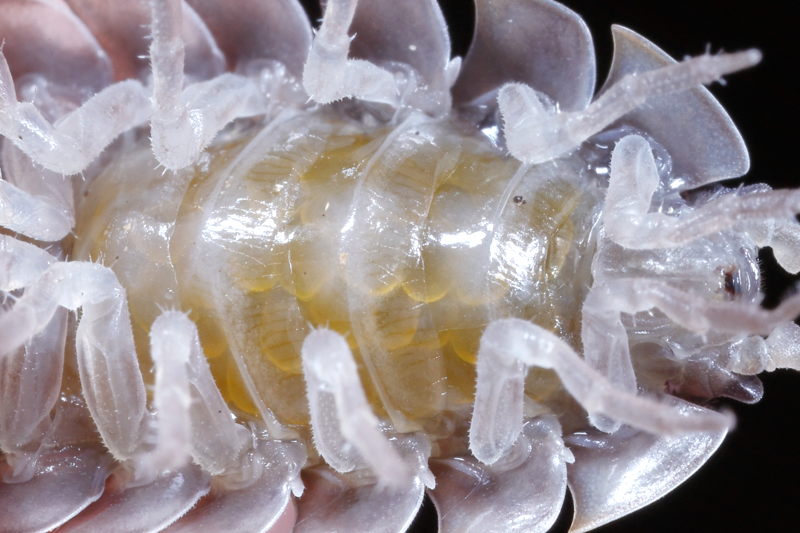
brood pouch, Common Woodlouse, start
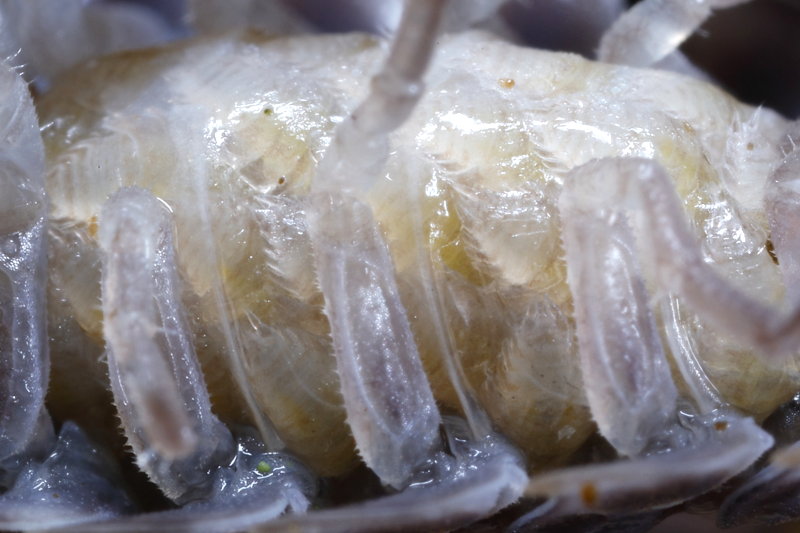
brood pouch, end
Newborn Woodlice are very similar to the adults, however, they have six pairs of legs and six back segments, this is called the manca stage. The adult animals have seven pairs of legs and seven back segments. After a few moults the young animals are also mature. The molting and thus grow, continues in the adult animals.

manca phase
All Woodlice do moult, not like insects the skin at once but only half their skin at a time. First goes one half of the body than the other half. Sometimes first for, sometimes first behind, like here on the pictures of two different Common Shiny Woodlice. At one animal the old skin is left beside, it has just moulted and you see the color difference between front and rear half of the body. This color difference can be seen as well at the other animal, and in addition, the rear part is wider than the front here. After this front part has moulted too, the animal is exact the same breadth all down its length. At the bottom two photos you see lying down the shed skin next to the animal. The woodlouse whose shed skin is in front of it, is now again all down its length exact the same breadth and so completely moulted. Underneath a Striped Woodlouse, clearly shows that the just shed part of the body is still pressed.

shedded Rough Woodlouse, Porcellio scaber
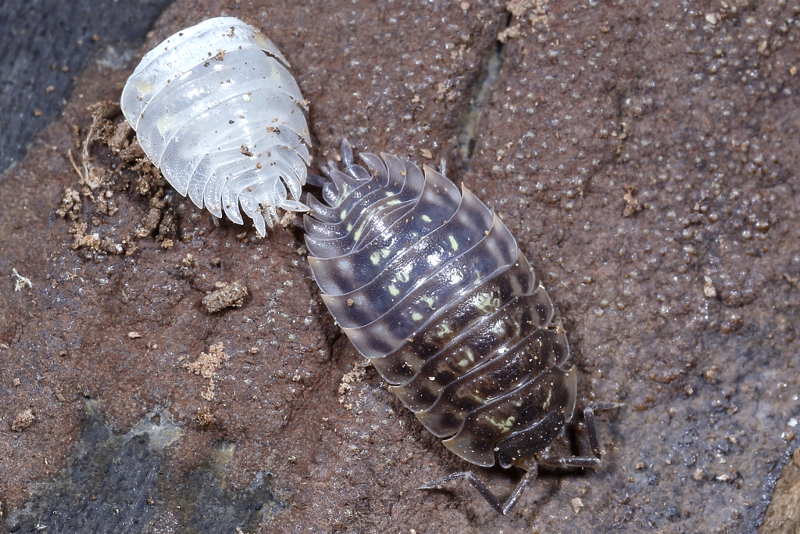
shedded Common Shiny Woodlouse, Oniscus asellus
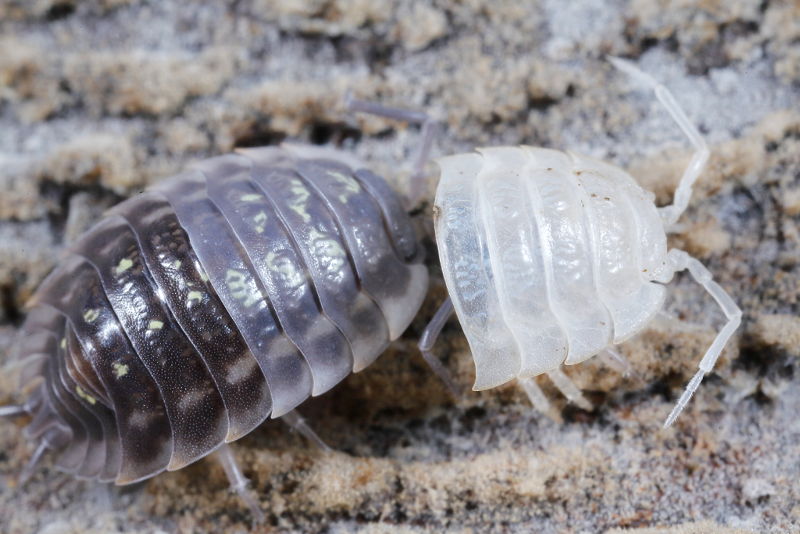
shedded Common Shiny Woodlouse, Oniscus asellus
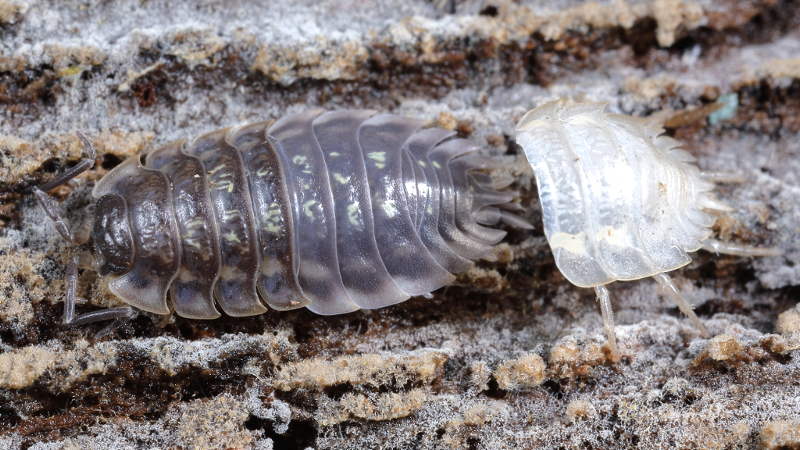
shedded Common Shiny Woodlouse, Oniscus asellus
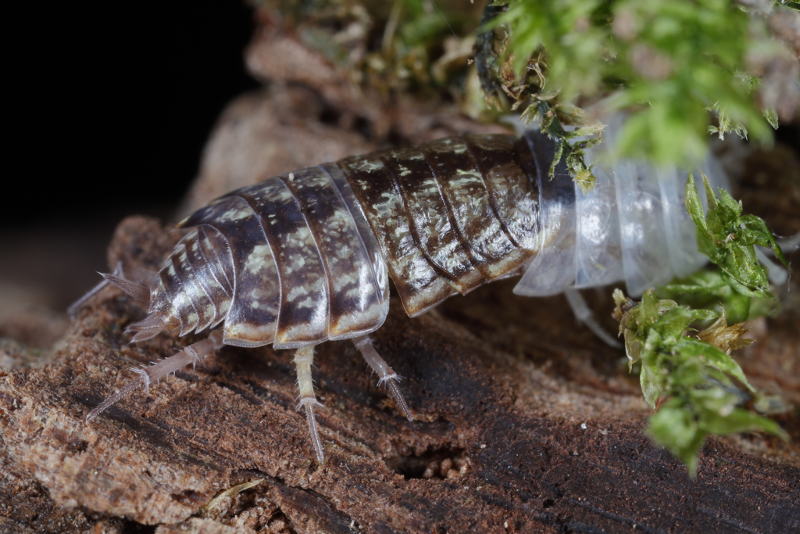
shedded Striped Woodlouse, Philoscia muscorum
Lose a woodlouse a paw or antenna, then it is able to regenerate it. At the next molt you see then a new, smaller and often depigmented leg or antenna. At the subsequent molt there is nothing more to see that it is regenerated.

Porcellio scaber with regenerated antenna
Sick, blue Woodlice
There is a virus disease for all species of Woodlice that is easy to recognize. If the disease is at its height, the woodlouse turns blue or purple by reflection of light on the virus crystals. Once colored the end of its life is near. It is a disease that is common and not infects humans. Woodlice who eat a dead animal that has died from the virus, become also sick. The causative agent is called Iridovirus.
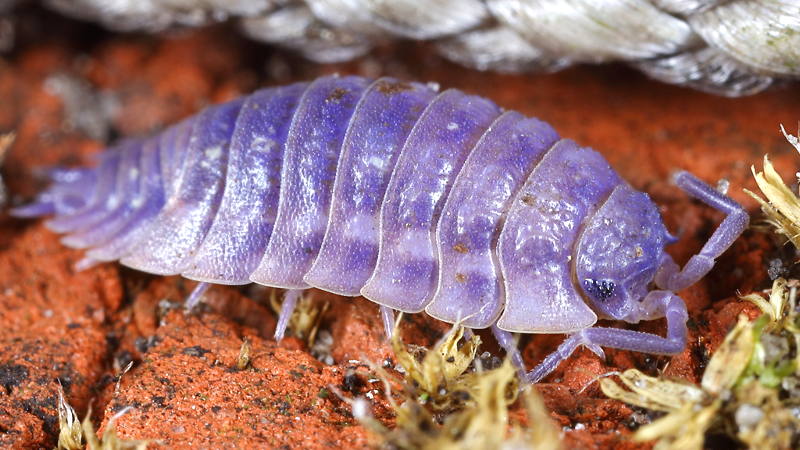
Common Shiny Woodlouse, Oniscus asellus, with iridovirus
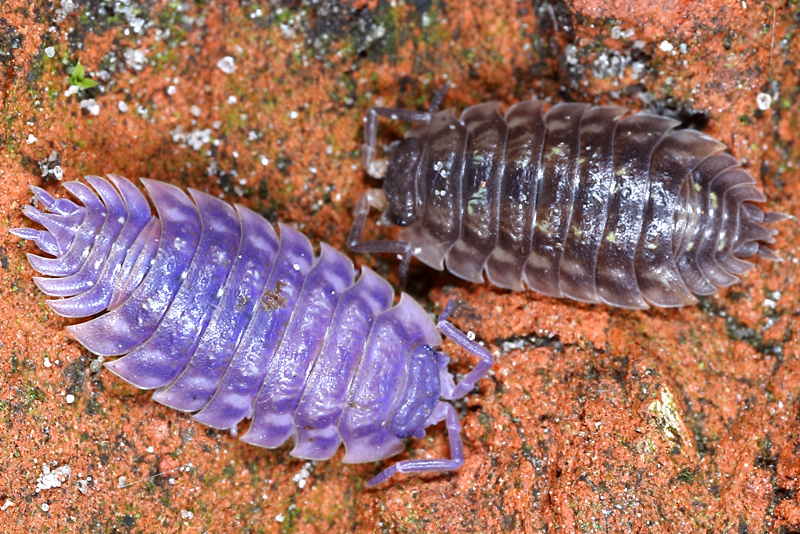
Kelderpissebed, Oniscus asellus, met iridovirus, right healthy specimen
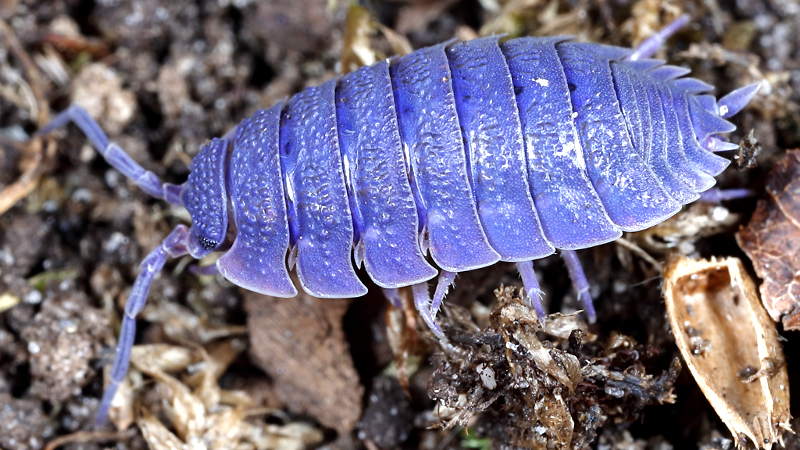
Rough Woodlouse, Porcellio scaber, with iridovirus
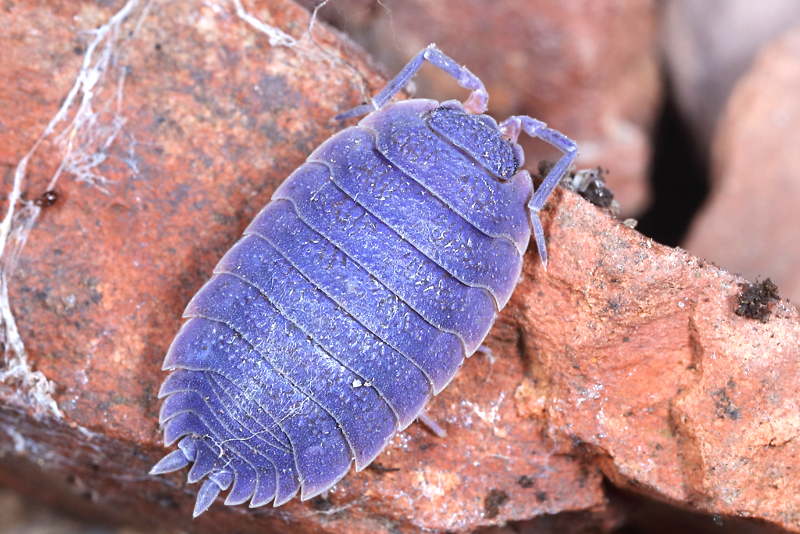
Rough Woodlouse, Porcellio scaber, with iridovirus
Difference pill bug and pill millipede
Pill Millipede, Glomeris marginata
Make no mistake if you see a little ball, it doesn't have to be a roll-up species of woodlouse. In The Netherlands there
is a centipede, which also masters the trick.
Just like the pill bug the Glomeris marginata can also roll up and as it walks, it looks like a
pill bug. The characteristic difference is that pill bugs have seven back segments followed by five tail segments
that suddenly are much narrower than the back segments.
With the centipede the segments are narrower to behind and not suddenly go into a tail.
The centipede has, as the name suggests, more legs, two pairs per segment, the pill bugs have to do it with a
total of seven pairs of legs.
One pair per segment, clearly visible at the on the back lying pill bug. There are also whole brown individuals but
these are much rarer. However, it can also be a newly moulted animal. The juveniles are mottled.
Be careful, that below is no pill bug, but a pill millipede.
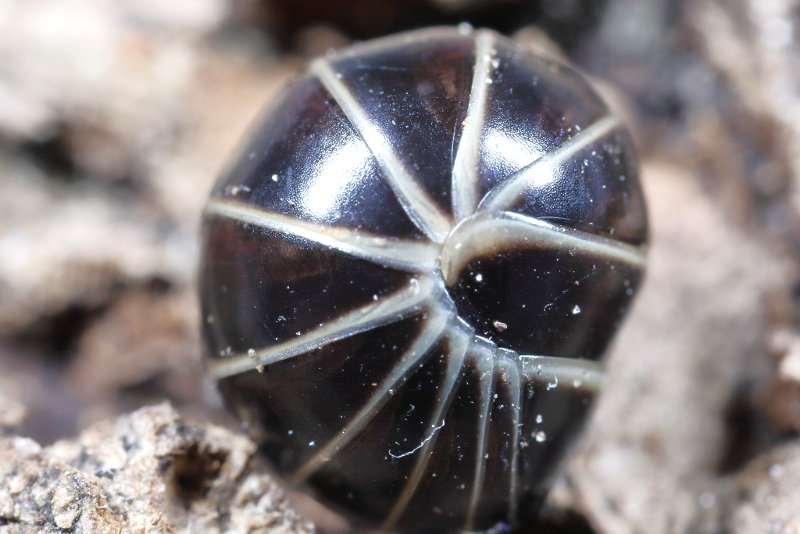
pill millipede, Glomeris marginata

pill millipede, Glomeris marginata
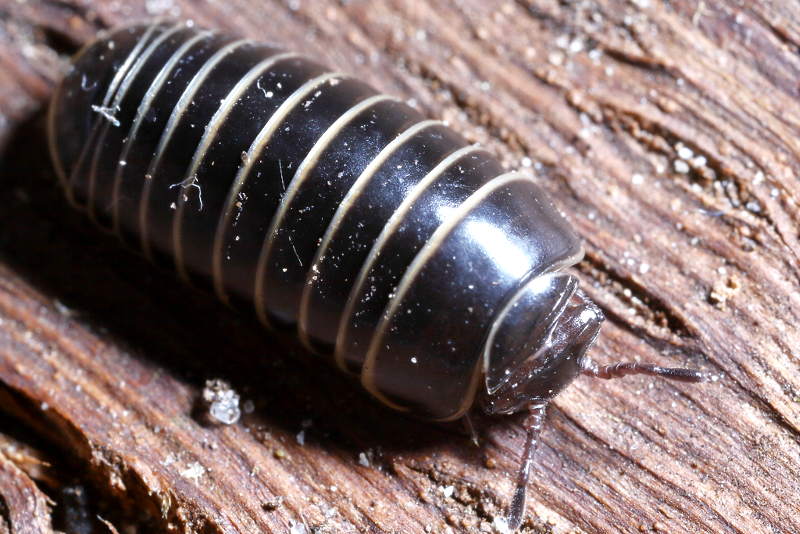
pill millipede, Glomeris marginata
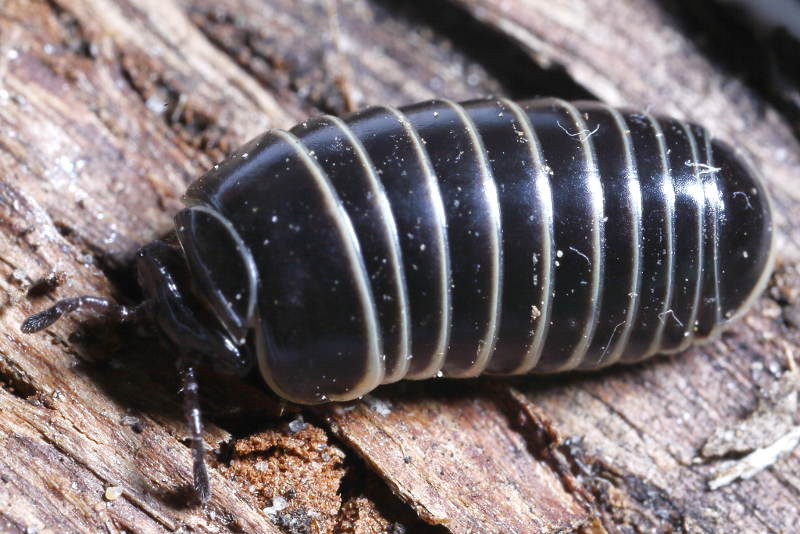
pill millipede, Glomeris marginata
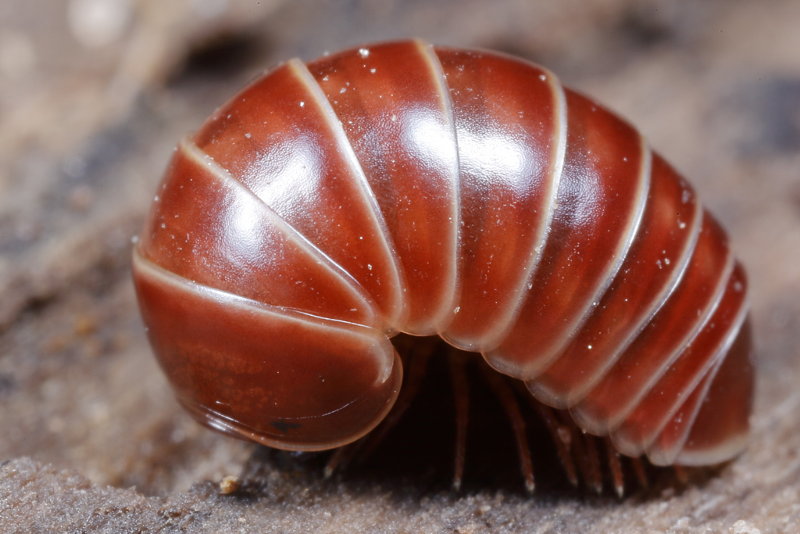
pill millipede, Glomeris marginata
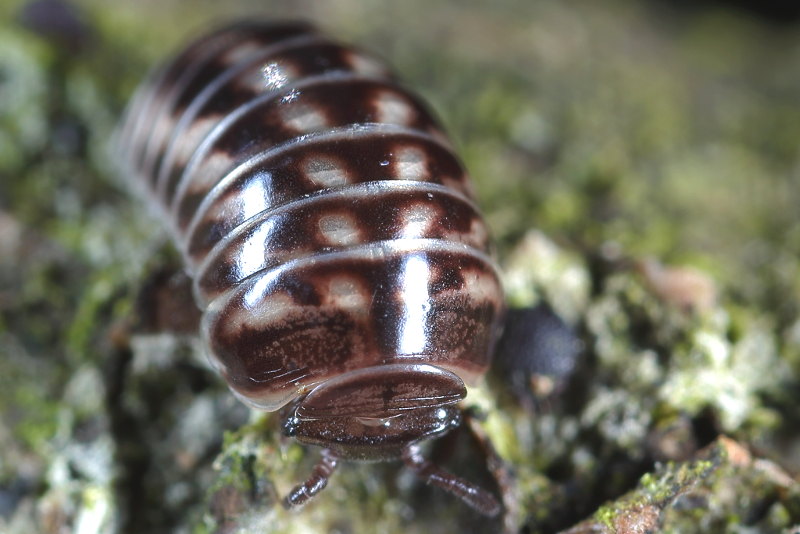
pill millipede, Glomeris marginata juvenile
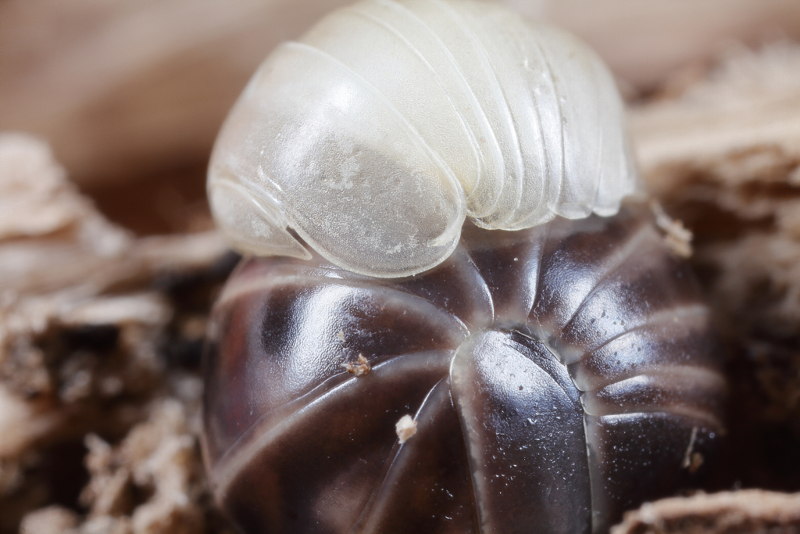
pill millipede, Glomeris marginata, just shedded with old skin
Dutch Terrestrial Woodlice
Of most tropical greenhouse species and two rare species I have no photos, these are not clickable in the list.
- family: Armadillidiidae
- Armadillidium album Dollfus, 1887 - Beach Pill Woodlouse
- Armadillidium nasatum Budde-Lund, 1885 - Pill Woodlouse
- Armadillidium opacum (Koch, 1841) - Pill Woodlouse
- Armadillidium pictum Brandt, 1833 - Pill Woodlouse
- Armadillidium pulchellum (Zenker, 1799) - Pill Woodlouse
- Armadillidium vulgare (Latreille, 1802) - Common Pill Woodlouse
- Eluma caelatum (Miers, 1877)
- family: Armadillidae
- Armadillo officinalis Dumeril, 1816 (tropical greenhouses)
- Reductoniscus costulatus Kesselyak, 1930 (tropical greenhouses)
- Synarmadillo pallidus Arcangeli, 1950 (tropical greenhouses)
- Venezillo parvus (Budde-Lund, 1885) (tropical greenhouses)
- familie: Cylisticidae
- Cylisticus convexus (De Geer, 1778) - Curly Woodlouse
- family: Ligiidae
- Ligia oceanica (Linnaeus, 1767) - Common Sea Slater
- Ligidium hypnorum (Cuvier, 1792) - Carr Slater
- family: Oniscidae
- Oniscus asellus Linnaeus, 1758 - Common Shiny Woodlouse
- family: Philosciidae
- Anchiphiloscia balssi (Verhoeff, 1928) (tropical greenhouses)
- Philoscia muscorum (Scopoli, 1763) - Striped Woodlouse
- family: Platyarthridae
- Platyarthrus hoffmannseggii Brandt, 1833 - Ant Woodlouse
- Trichorhina tomentosa (Budde-Lund, 1893) (tropical greenhouses)
- family: Porcellionidae
- Porcellio dilatatus Brandt, 1833 - Woodlouse
- Porcellio laevis Latreille, 1804 - Woodlouse
- Porcellio scaber Latreille, 1804 - Rough Woodlouse
- Porcellio spinicornis Say, 1818 - Painted Woodlouse
- Porcellionides pruinosus (Brandt, 1833) - Plum Woodlouse
- family: Styloniscidae
- Cordioniscus stebbingi (Patience, 1907) - Stebbing's Woodlouse (tropical greenhouses)
- family: Trachelipodidae
- Nagurus cristatus (Dollfus, 1889) - Woodlouse (tropical greenhouses)
- Porcellium conspersum (Koch, 1841) - Woodlouse
- Trachelipus rathkii (Brandt, 1833) - Rathke's Woodlouse
- family: Trichoniscidae
- Androniscus dentiger Verhoeff, 1908 - Rosy Woodlouse
- Haplophthalmus danicus Budde-Lund, 1880 - Spurred Ridgeback
- Haplophthalmus mengei (Zaddach, 1844) - Common Ridgeback
- Haplophthalmus montivagus Verhoeff, 1941 - Southern Ridgeback
- Hyloniscus riparius (Koch, 1838) - Woodlouse
- Metatrichoniscoides leydigii (Weber, 1880) - Woodlouse
- Miktoniscus patiencei Vandel, 1946 - Coastal Black-eye
- Trichoniscoides albidus (Budde-Lund, 1880) - Rough Pygmy Woodlouse
- Trichoniscoides helveticus (Carl, 1908A) - Swiss Red-eye
- Trichoniscoides sarsi Patience, 1908 - Sars' Red-eye
- Trichoniscus pusillus/provisorius - Common Pygmy Woodlouse
- Trichoniscus pygmaeus Sars, 1898 - Least Pygmy Woodlouse
Dutch water- and sea slater
There are many more species than the two mentioned.
- freshwater family: Asellidae
- Asellus aquaticus (Linnaeus, 1758) - Two-spotted Waterlouse/Two-spotted Water-slater
- seawater/brackish water family: Sphaeromatidae
- Lekanesphaera rugicauda (Leach, 1814) - Sea slater
Pill Woodlouse, Armadillidium nasatum
When looking for harvestmen on the Maasvlakte, of course, we also look to other animals. Arp discovered
Armadillidium nasatum, one of the rare Pill Woodlice.
The animal is quite cooperative and I can easyly
make some pictures of it. At this species is the up folded nose the attribute.
Is it rolled then the ball is not perfect, the antennas still protruding.
The color may vary, such as in the light individual of the last picture.
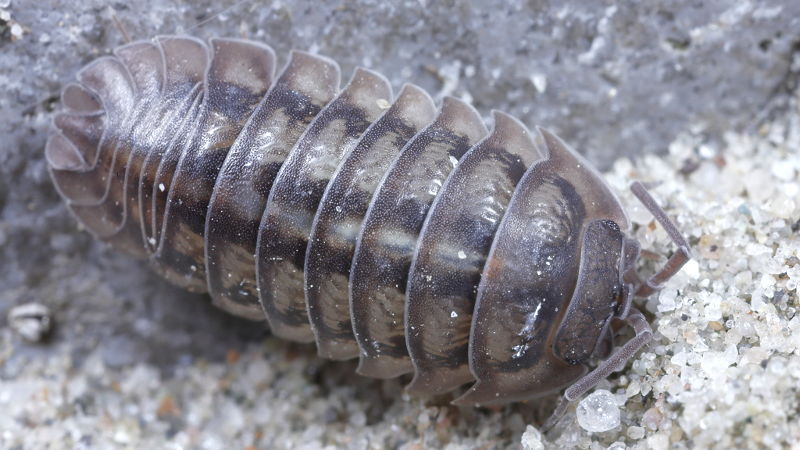
Pill Woodlouse, Armadillidium nasatum
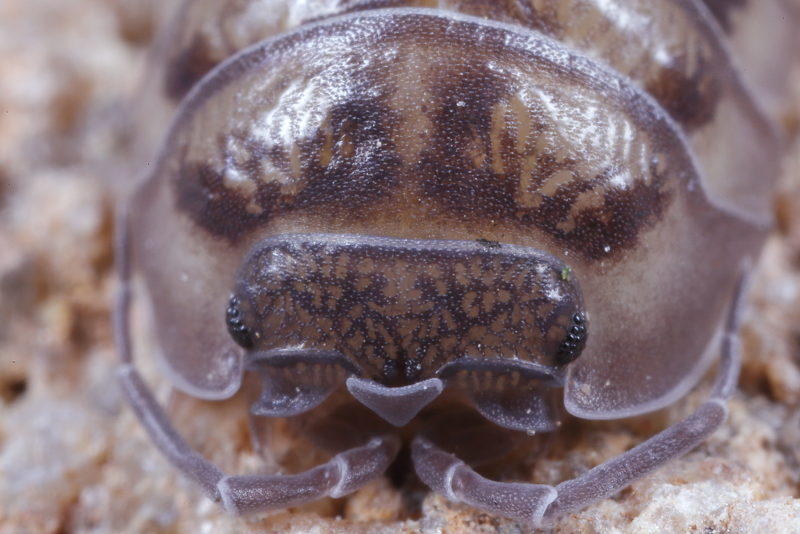
Pill Woodlouse, Armadillidium nasatum
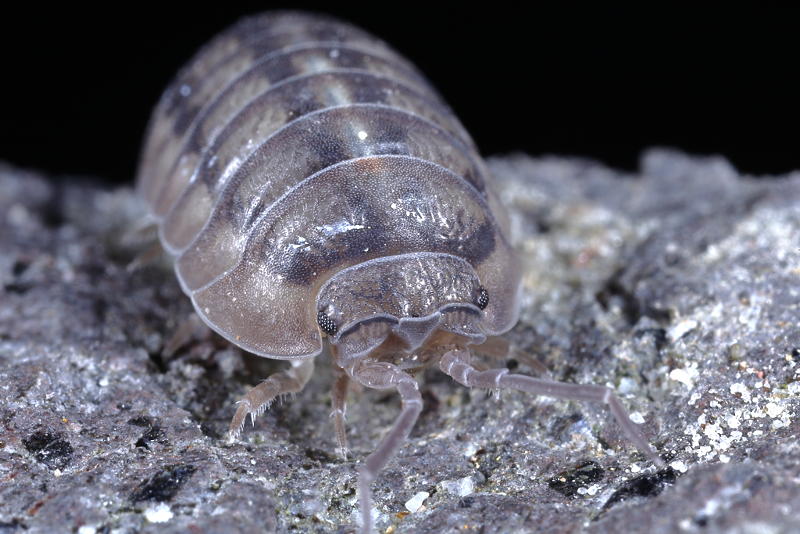
Pill Woodlouse, Armadillidium nasatum
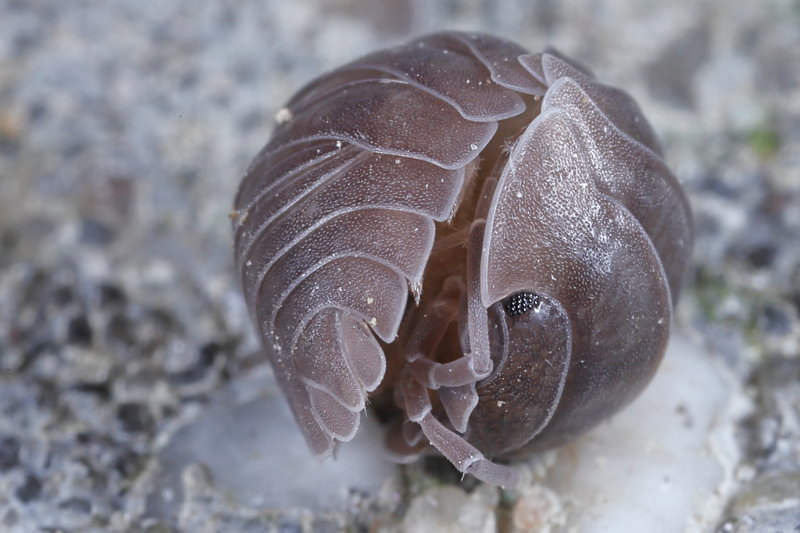
Pill Woodlouse, Armadillidium nasatum
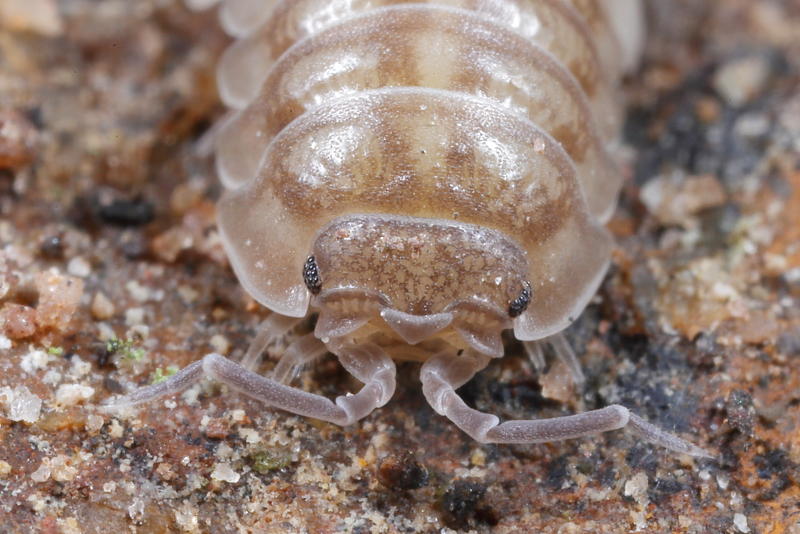
Pill Woodlouse, Armadillidium nasatum
Pill Woodlouse, Armadillidium opacum
Near the quarry in Winterswijk, I find under a piece of bark two pill woodlice.
One of them runs very fast and I'm afraid he will fall to the ground before I can make pictures.
I am lucky, on the edge of the piece bark he remains sit still. Nearby under an other piece of bark is still a third.
From all individuals I make pictures and from one I suspect it is the rare
Pill Woodlouse Armadillidium opacum. All three I put on the forum of waarnemingen.nl
and get immediately the enthusiastic response from Arp Kruithof that it all three are Armadillidium opacum
The difference with the Common Pill Woodlouse is the general appearance, they are much broader and have a nose with two
pimples behind it. They can also roll up into a ball.

Pill Woodlouse, Armadillidium opacum
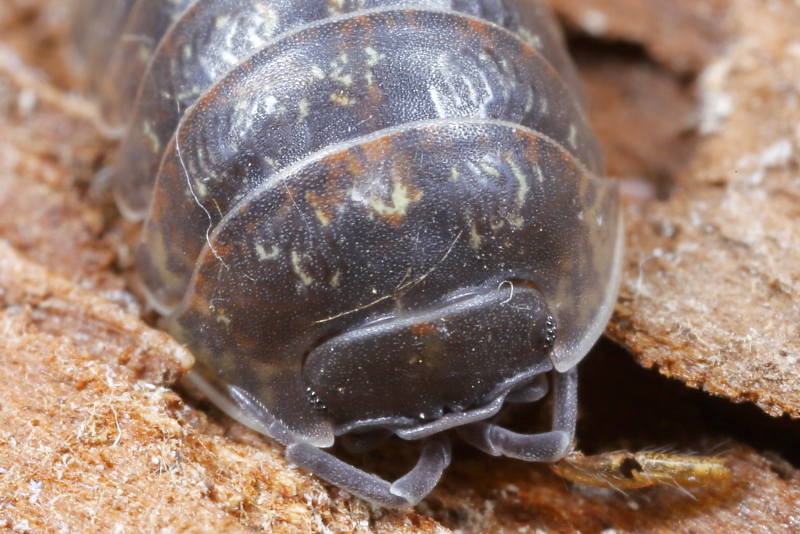
Pill Woodlouse, Armadillidium opacum

Pill Woodlouse, Armadillidium opacum
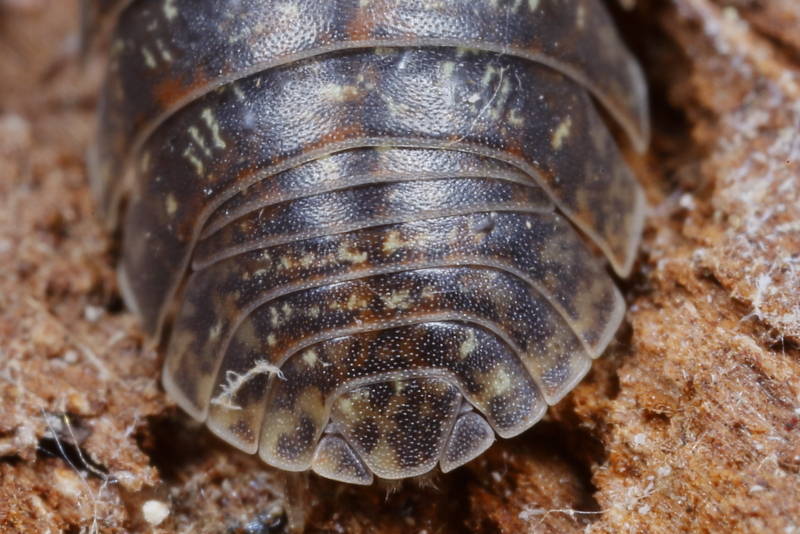
Pill Woodlouse, Armadillidium opacum
Pill Woodlouse, Armadillidium pictum
To the images you can not see it but this species of woodlouse is only 9 mm long. This is a rare species and Arp has ensured that I can make pictures of it. Later I discover an animal under a loose piece bark on the bottom of a forest in the Veluwe zoom. They are animals that appear in old forests on a calcareous soil, where they live under the bark of dead trees. It are real pill woodlice that roll up and let drop itself if they are disturbed. On the forest floor, it is very difficult to find such a small ball. They are bound to a humid environment. The telson (the last piece shield of the tail) is triangular and with this it differs from the Armadillidium pulchellum where the telson is much rounder.

Pill Woodlouse, Armadillidium pictum

Pill Woodlouse, Armadillidium pictum
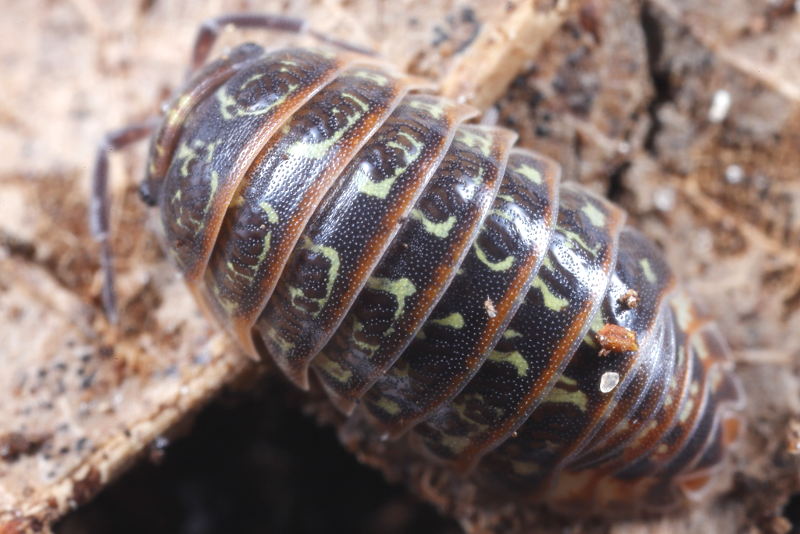
Pill Woodlouse, Armadillidium pictum
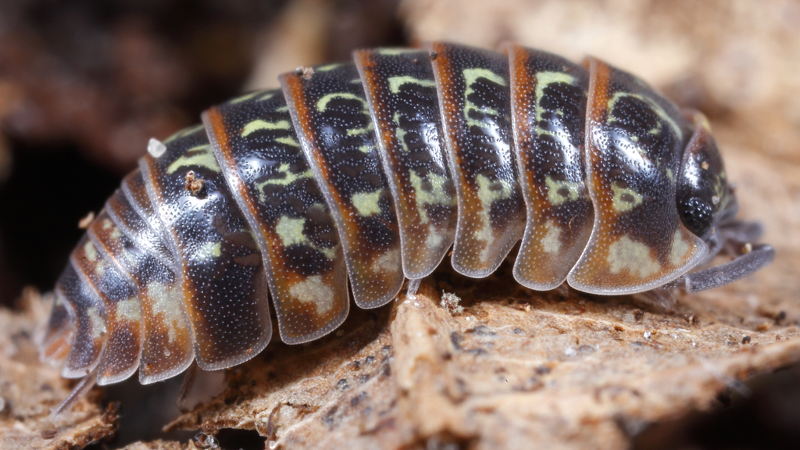
Pill Woodlouse, Armadillidium pictum
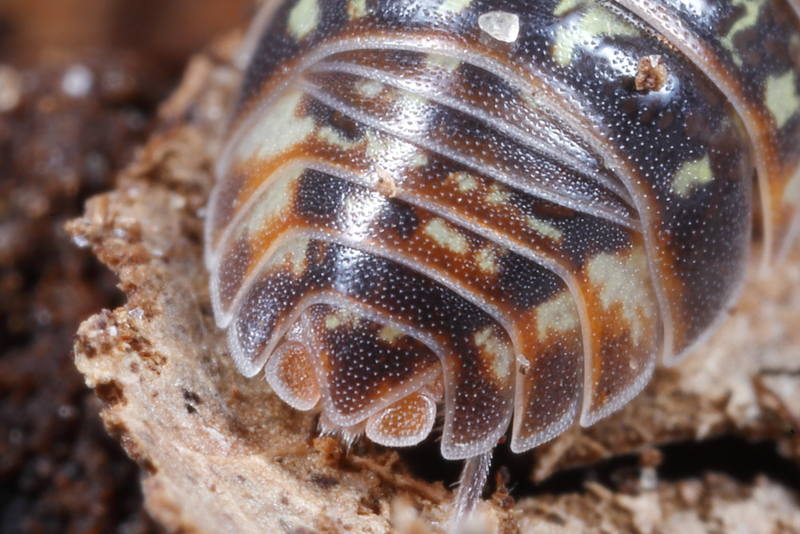
Pill Woodlouse, Armadillidium pictum

Pill Woodlouse, Armadillidium pictum
Pill Woodlouse, Armadillidium pulchellum
Armadillidium pulchellum looks very much alike the Armadillidium pictum. You really need to look very closely to see the differences. He remains smaller, 6 mm by 9 mm from the A. pictum. The rear corners of the first body segment are not pointed but cut off, a property where you actually need to see both types next to each other. An easier feature I find the shape of the telson, (the last piece shield of the tail), in this species it is round and with this it differs from the A. pictum where the telson is triangular. This species is rare in the Netherlands, there are only a small number of sites. The animal of the photos comes from Twente, from a nature reserve called the Wildernis near Hengelo and is found again by Arp. Preferred places of this species of woodlouse are the drier spots, on the ground beneath a piece of bark that as an umbrella has stopped the rain, or under bark of dead upright standing trees.
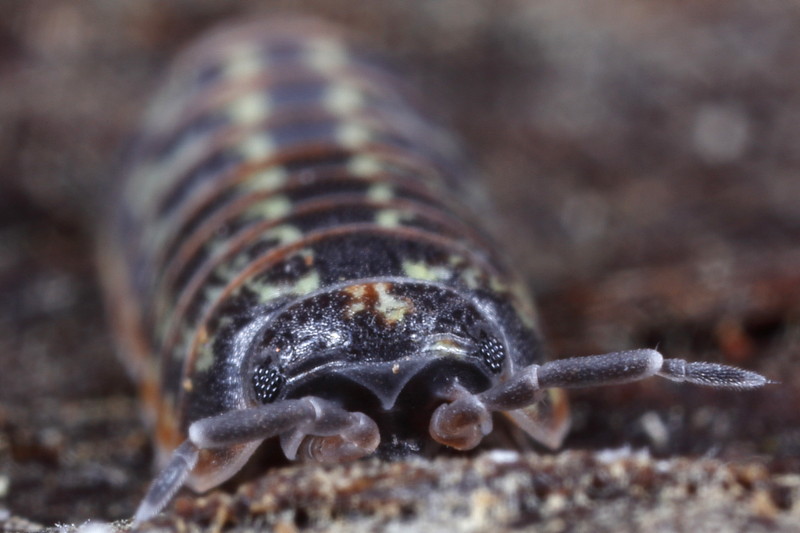
Pill Woodlouse, Armadillidium pulchellum
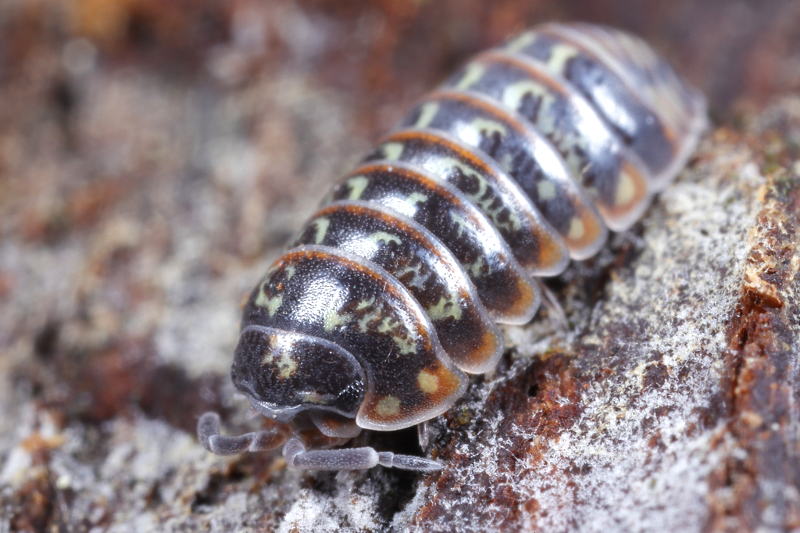
Pill Woodlouse, Armadillidium pulchellum
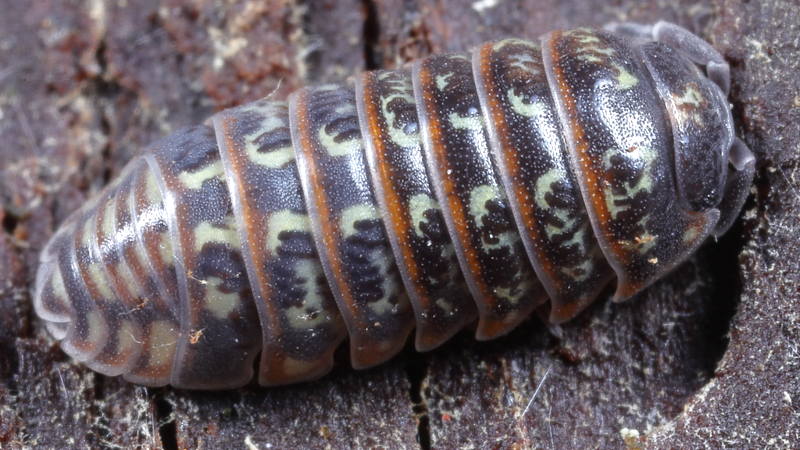
Pill Woodlouse, Armadillidium pulchellum
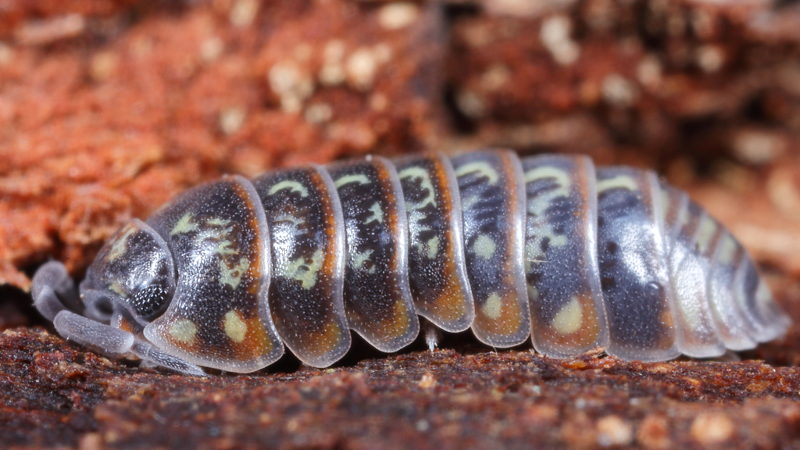
Pill Woodlouse, Armadillidium pulchellum
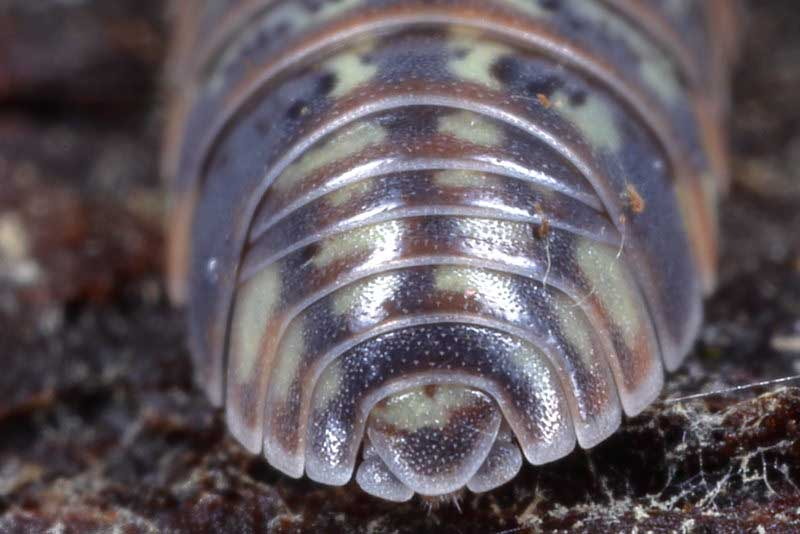
Pill Woodlouse, Armadillidium pulchellum
Common Pill Woodlouse, Armadillidium vulgare
De Common Pill Woodlouse Armadillidium vulgare rolls on to a perfect ball when disturbed. An rolled up Woodlouse looks like a pill, that is why it are called pillbugs. It's a good way of defense, all protruding parts as legs and feelers are neatly hidden, such as on the top photo is clearly visible. It is a common species, but near me in South East Drenthe on the sandy soil I don't see it.

Common Pill Woodlouse, Armadillidium vulgare
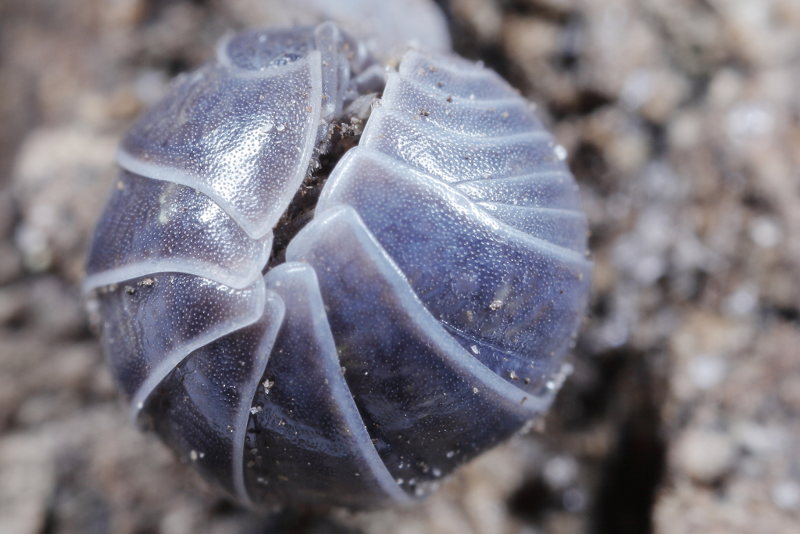
Common Pill Woodlouse, Armadillidium vulgare
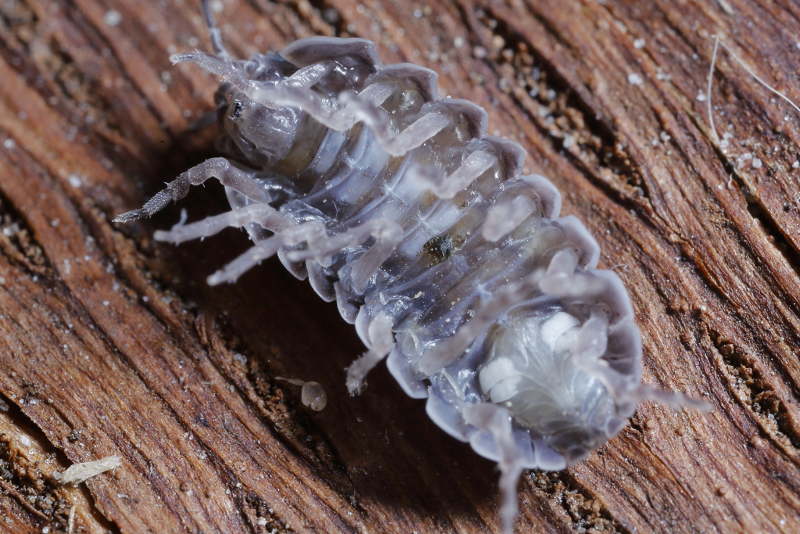
Common Pill Woodlouse, Armadillidium vulgare
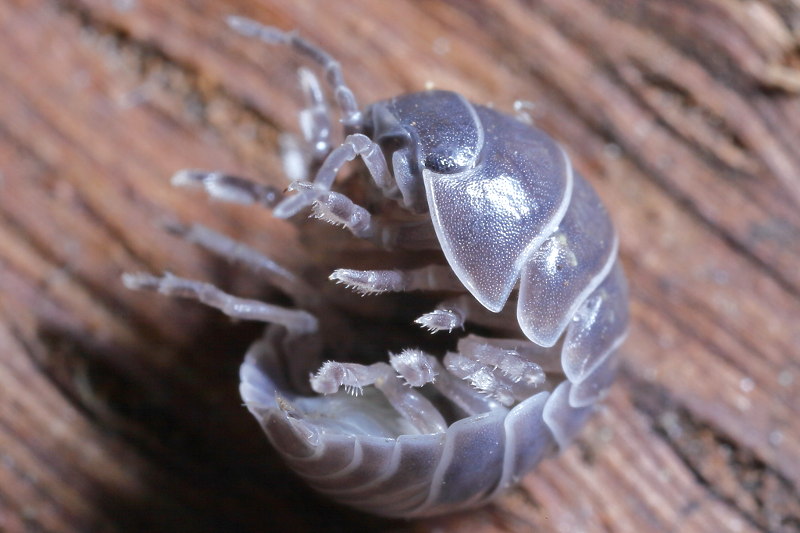
Common Pill Woodlouse, Armadillidium vulgare
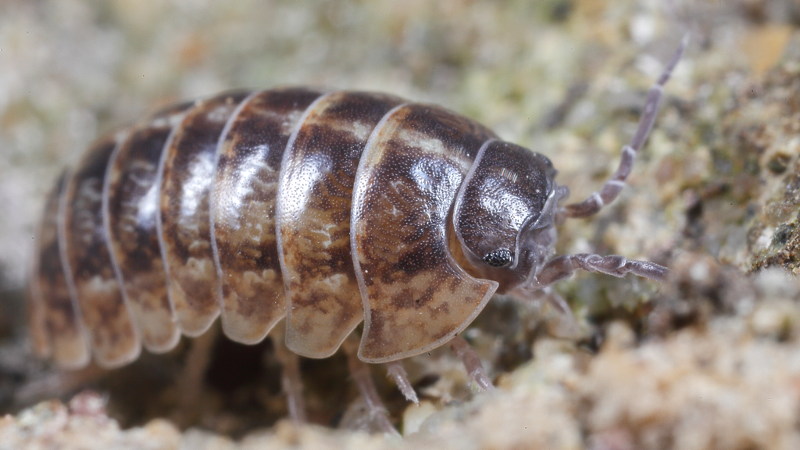
Common Pill Woodlouse, Armadillidium vulgare
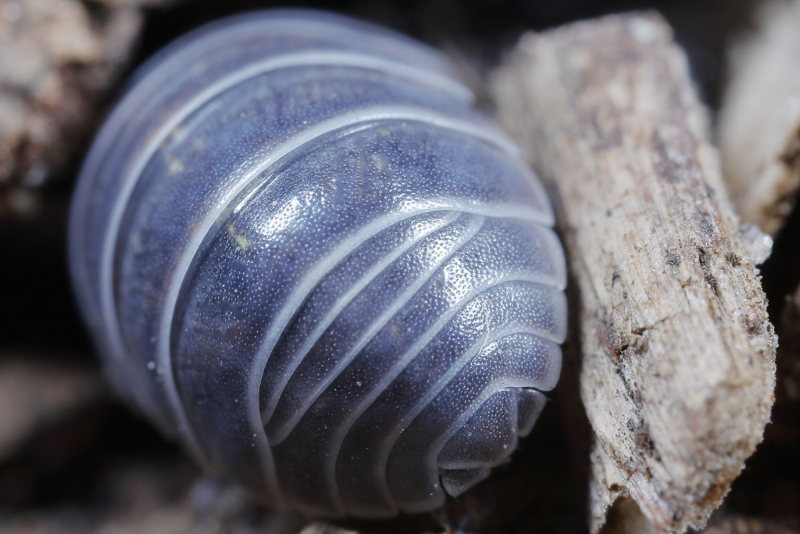
Common Pill Woodlouse, Armadillidium vulgare

Common Pill Woodlouse, Armadillidium vulgare

Common Pill Woodlouse, Armadillidium vulgare

Common Pill Woodlouse, Armadillidium vulgare

Common Pill Woodlouse, Armadillidium vulgare
Eluma caelatum
Eluma caelatum is a rare species that occurs only in The Netherlands in Zeeland. They live at the foot of the dunes and among mosses on dikes that are lying in the Sun. It is a roll-up isopod that is distinguishable from the others because it has only a single ocel. Furthermore, the animal is hairy what you don't see in the others as well. The animals on the photos are found by Matty Berg, an animal that I found was to rapidly for me, as soon as they unfurl they run away with great speed.

Eluma caelatum
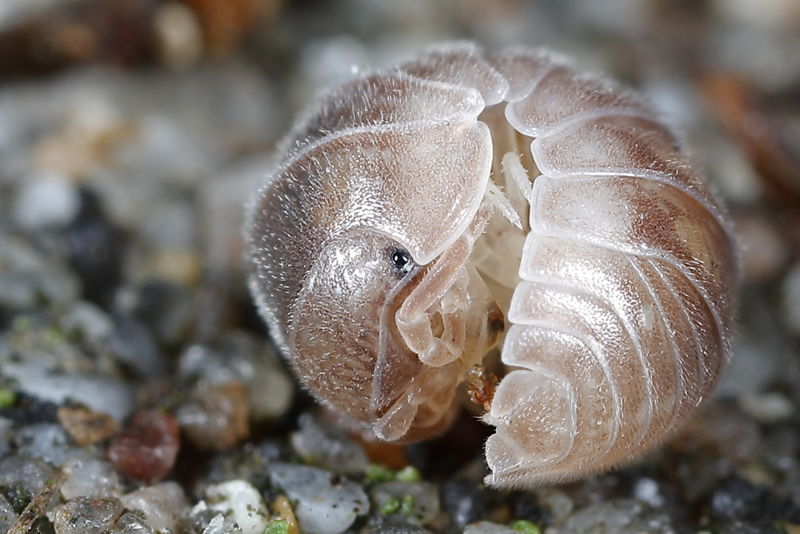
Eluma caelatum
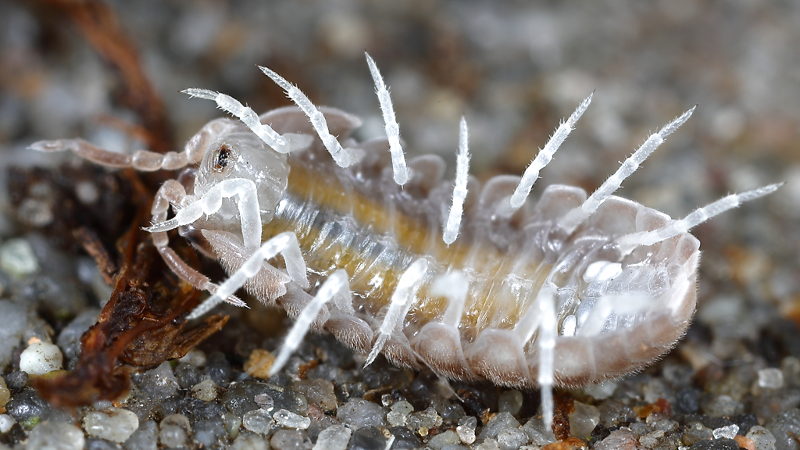
Eluma caelatum
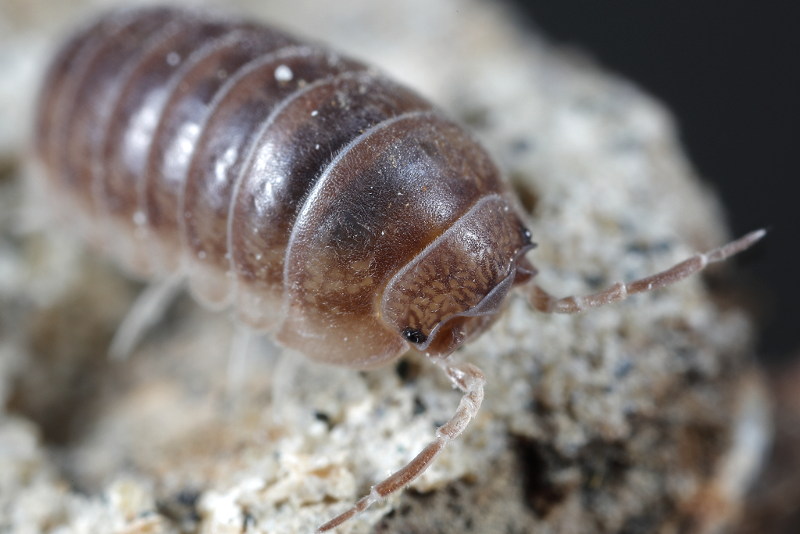
Eluma caelatum
Venezillo parvus
Venezillo parvus is a species of the tropics and sub-tropics. In The Netherlands is an animal that is found in tropical greenhouses, outdoor he may not survive. It is very rare here, known from only three greenhouses. The animals depicted here are found by Arp. It is a lively painted species that is relatively small, 5 mm and gives a rather different picture to the back, next to the hourglass shaped telson crosses the endopods as a small stalk out.
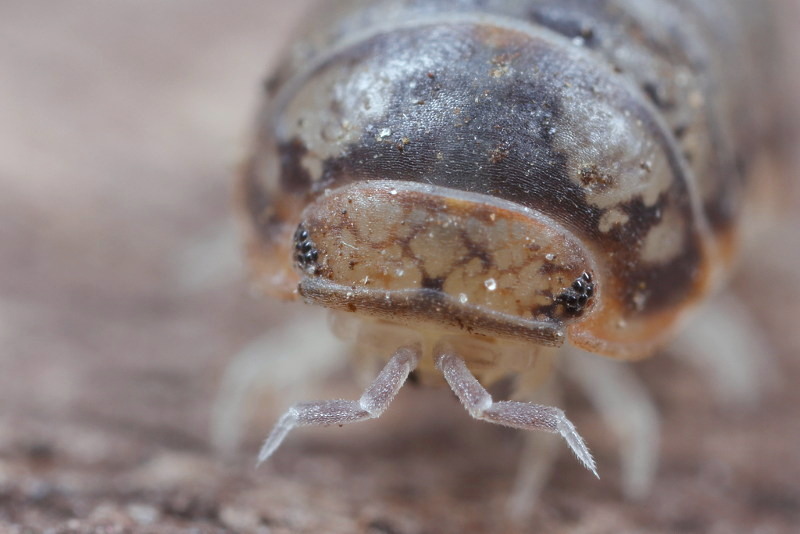
Venezillo parvus
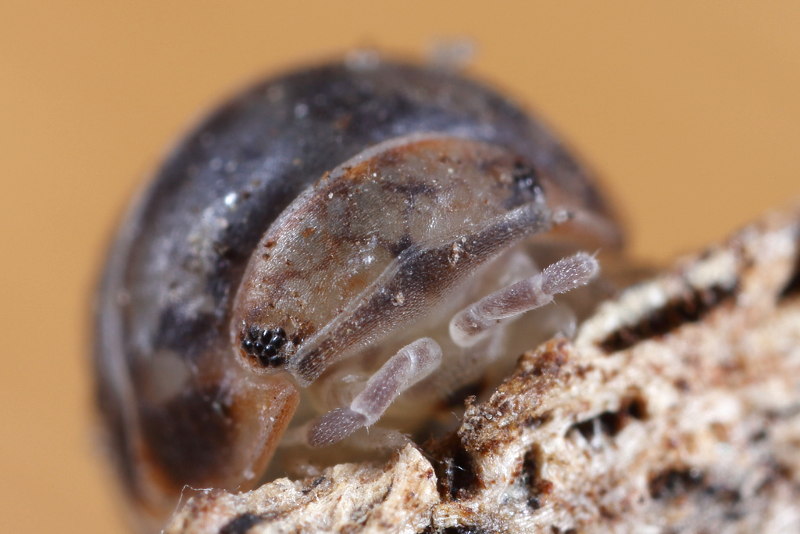
Venezillo parvus
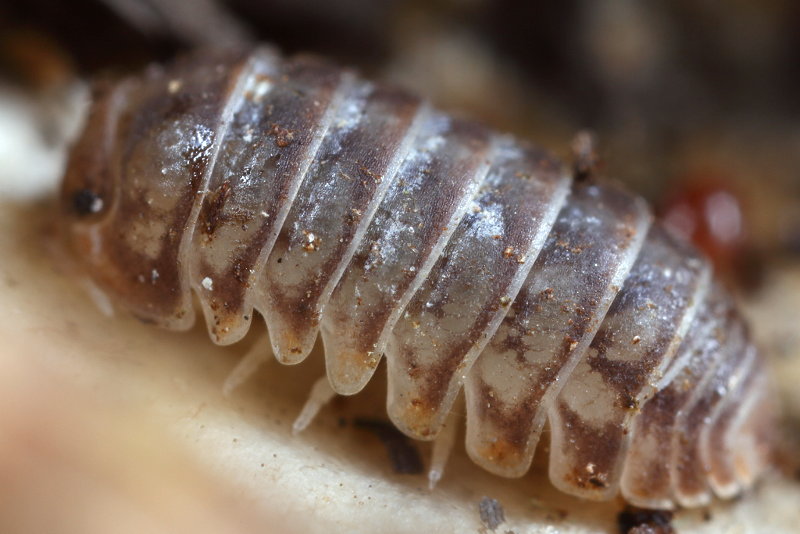
Venezillo parvus
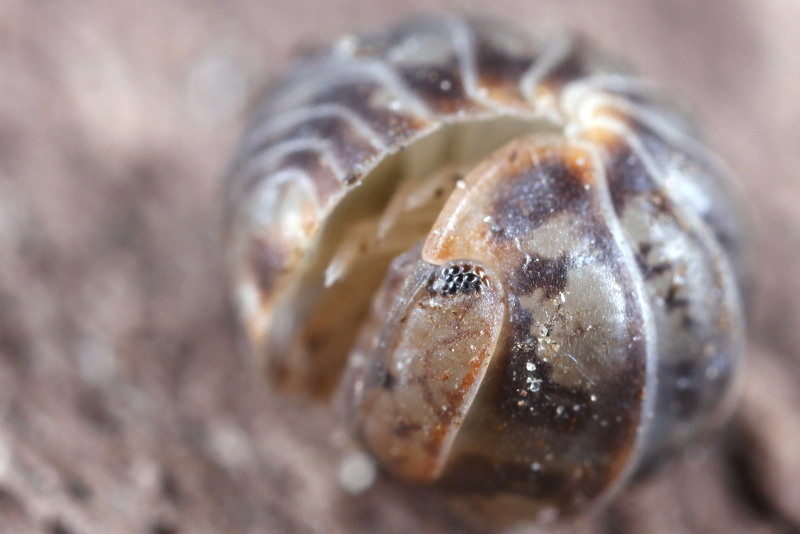
Venezillo parvus
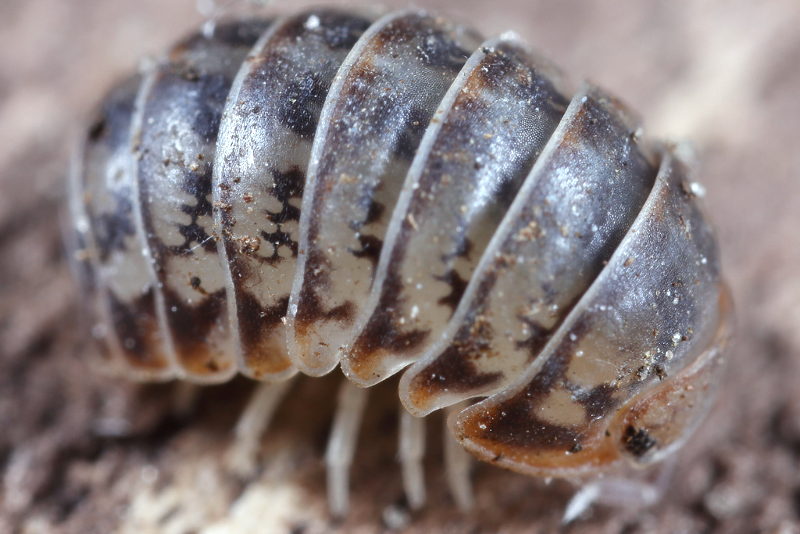
Venezillo parvus
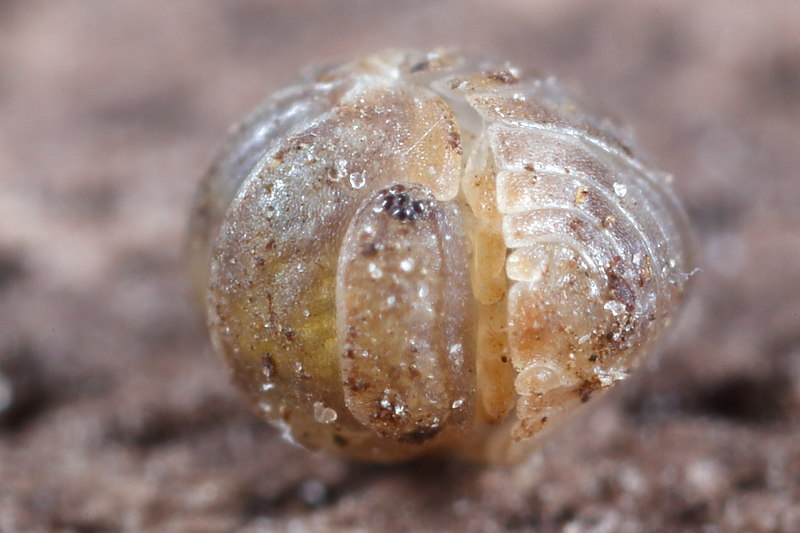
Venezillo parvus, juveniel

Venezillo parvus
Common Sea Slater, Ligia oceanica
The Common Sea Slater I found on a dyke on the Maasvlakte between the stones quite far from the water. It is a young individual, which you can see from the spots on the body, the adult animals are uniform in color, green or brown. The animals can themselves vary and adapt the spots to the environment. only adult animals do that much less. They are hard to confuse with other woodlice because they are flat. The latest antenna part consists of at least ten parts. Is a real coast animal of hard surface, so search under stones. The adult animals come from the shores of the North Sea Canal.
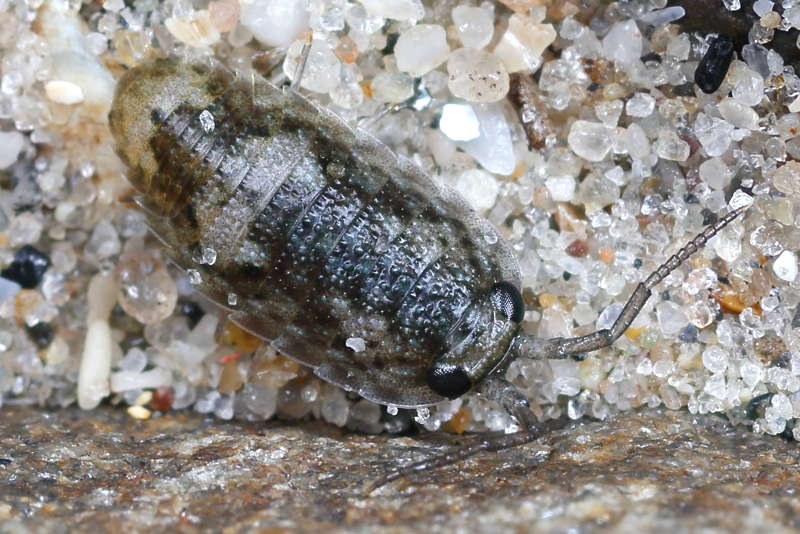
Common Sea Slater, Ligia oceanica, juvenile

Common Sea Slater, Ligia oceanica, juvenile
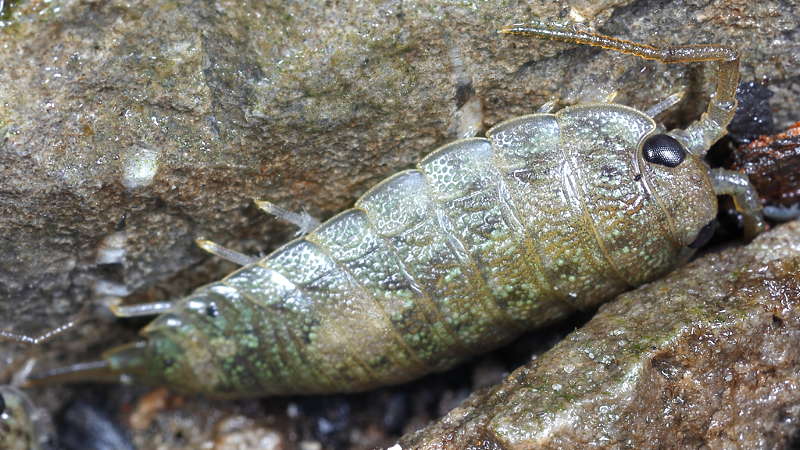
Common Sea Slater, Ligia oceanica
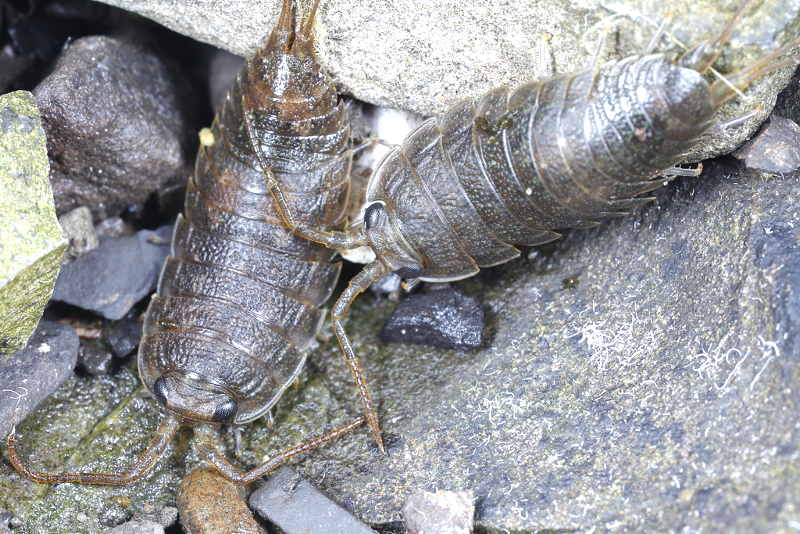
Common Sea Slater, Ligia oceanica
Carr Slater, Ligidium hypnorum
Very fast is the Carr Slater. The first time someone shows it to me in the field, I do not manage to photograph the animal. From Arp Kruithof I get a tube with three individuals for the photo. Problem, how do you get such fast animals sit still in front of the lens. They are animals that live in very wet environments, therefore a piece of old bark in a deep plate with water and the animals put on. Now it is good to see they are real water animals. They run from above the bark without any hesitation to under water. They are not good at swimming. They run underwater on the bark, on the smooth bottom, the glass plate, it's going significantly less quickly and they are also not capable to climb from underwater against the edge of the plate up. Another problem is that they are very shiny, along with the water surface gives this disturbing reflections of the flash units. After a large number of photos I have some where I am happy with and those you can see here. Striking is the latest antenna part that consists of multiple pieces and the appendages at the rear of the body are also very different from that of the resembling Striped Woodlouse. They are relatively small animals, that also resembles the Striped Woodlouse.

Carr Slater, Ligidium hypnorum
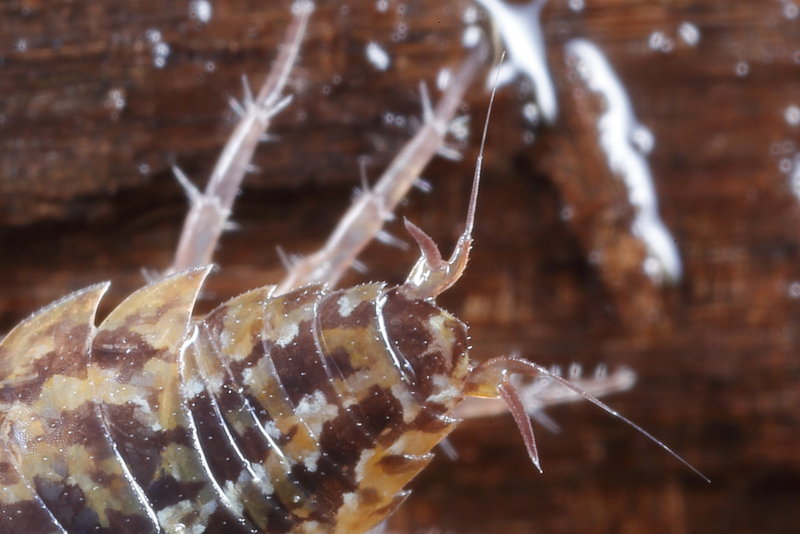
Carr Slater, Ligidium hypnorum
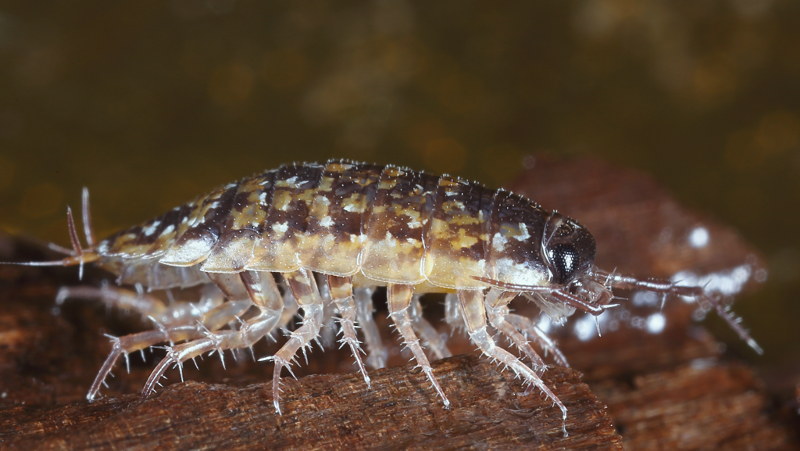
Carr Slater, Ligidium hypnorum
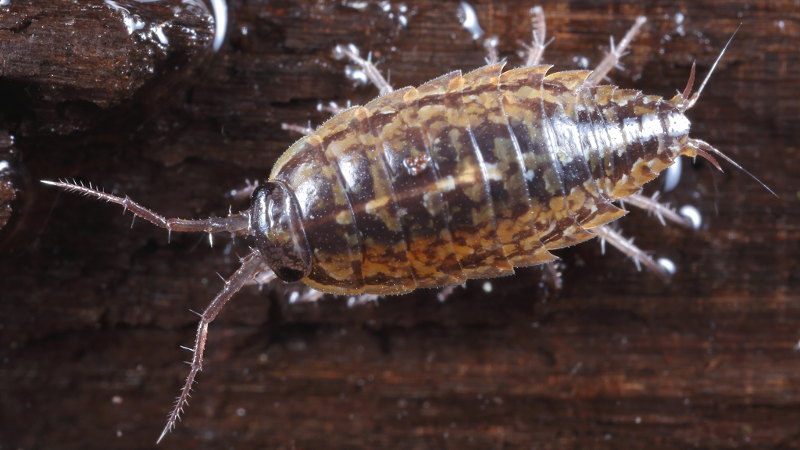
Carr Slater, Ligidium hypnorum
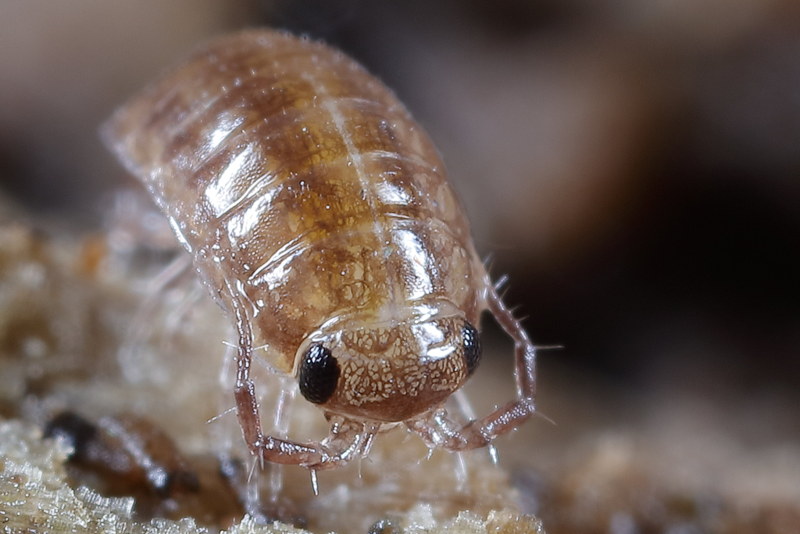
Carr Slater, Ligidium hypnorum, juvenile
Common Shiny Woodlouse, Oniscus asellus
The Common Shiny Woodlouse (Oniscus asellus) is somewhat shiny, smooth, often very broad, with bright approximately square spots along the edges, about the body randomly scattered yellow spots. Further features are: the last part of the antenna consists of three parts and under the eyes are large outward standing flaps. Young Common Shiny Woodlouse can cause confusion, they are quite rough and you can keep them for a Porcellio scaber. However, there are distinct features to these young animals. The points at the last segment of the back have orange spots, the last part of the antenna consists of three parts and the out standing flaps under the eyes are clearly present.
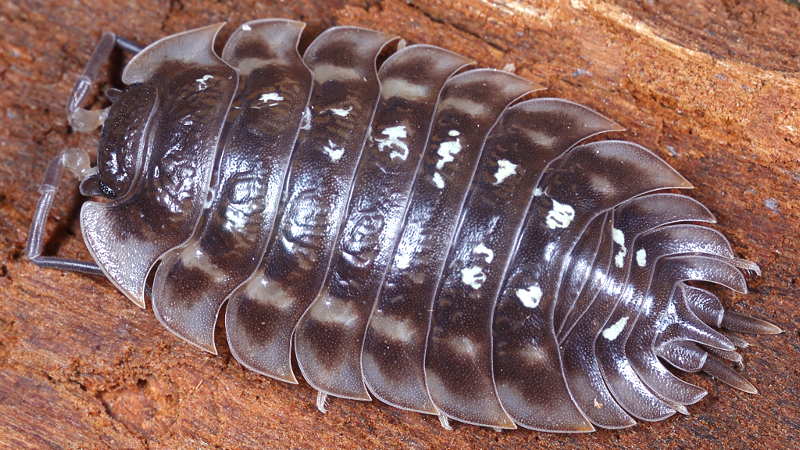
Common Shiny Woodlouse, Oniscus asellus

Common Shiny Woodlouse, Oniscus asellus

Common Shiny Woodlouse, Oniscus asellus juveniel
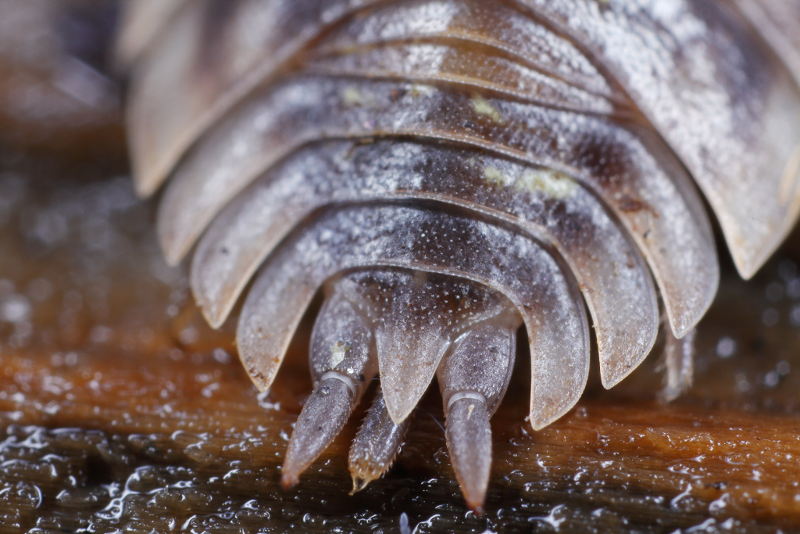
Common Shiny Woodlouse, Oniscus asellus
Below are some aberrant colors, first a brownish one, then on two pictures a white Common Shiny Woodlouse with black eyes, on the two pictures below it is an albino with reddish eyes. Below two pictures taken in the forest near home, this is a partial albino with dark red eyes and yellow spots on the back. At the very bottom, a partial albino, a multicoloured woodlouse, grey with white spots and the yellow spots are missing.

Common Shiny Woodlouse, Oniscus asellus brown
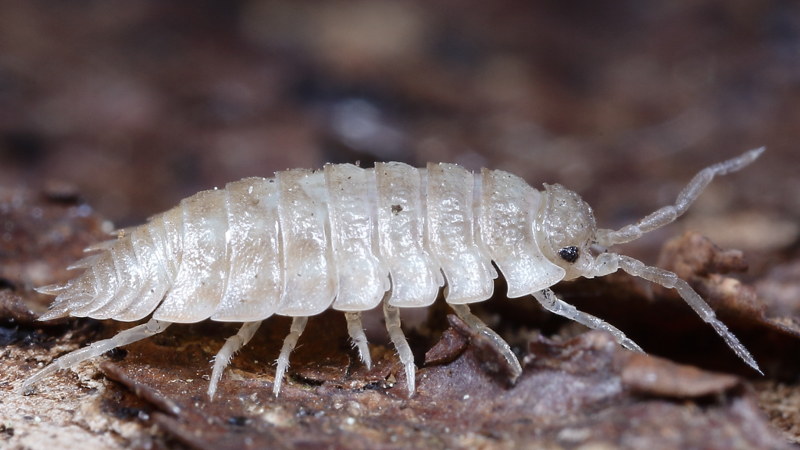
Common Shiny Woodlouse, Oniscus asellus white

Common Shiny Woodlouse, Oniscus asellus white

Common Shiny Woodlouse, Oniscus asellus albino
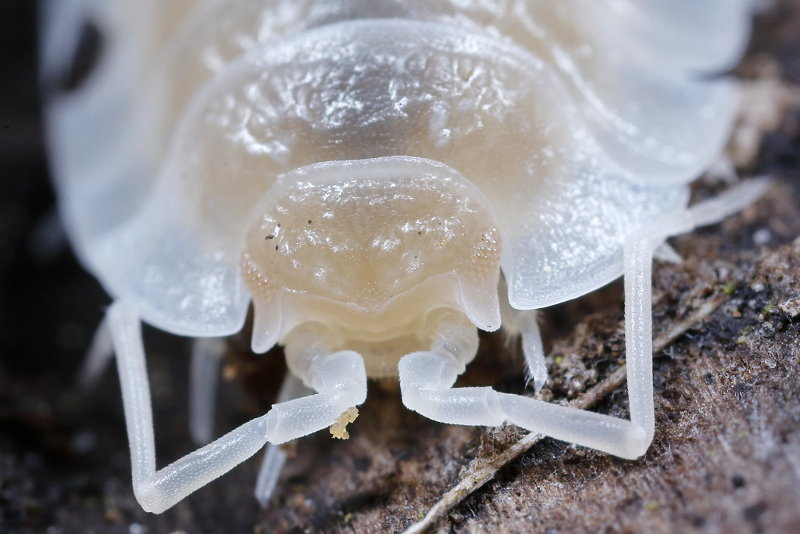
Common Shiny Woodlouse, Oniscus asellus albino
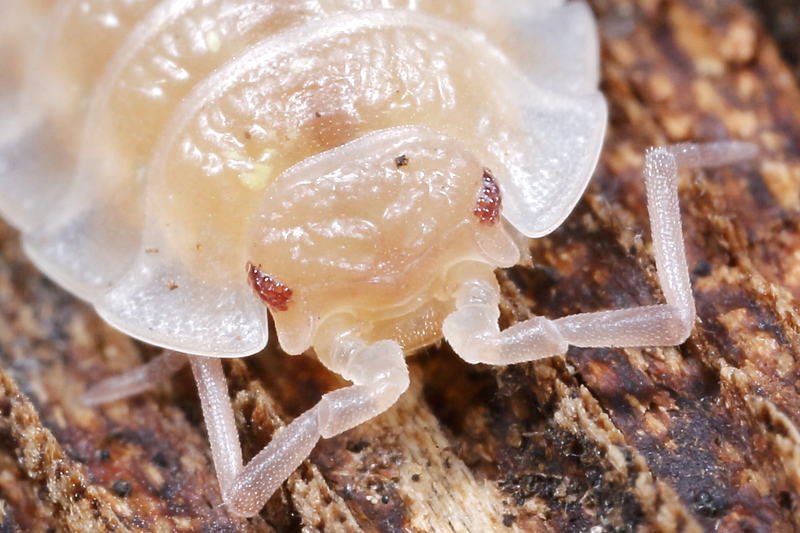
Common Shiny Woodlouse, Oniscus asellus albino
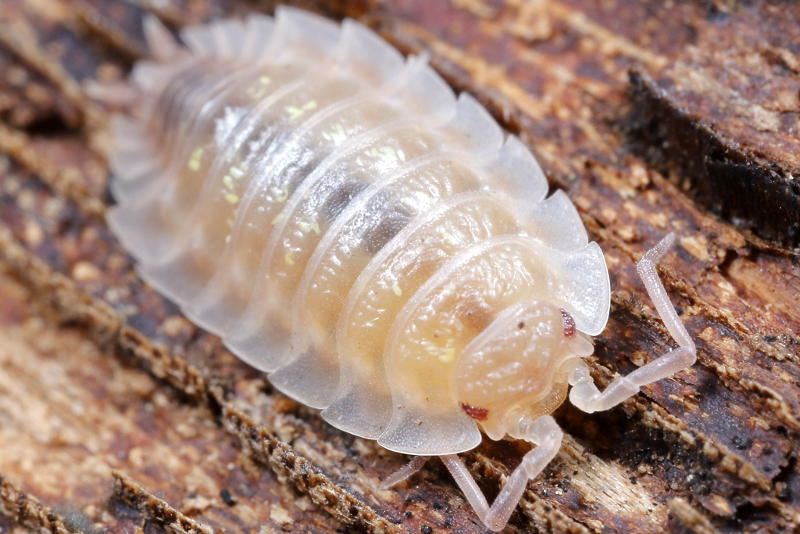
Common Shiny Woodlouse, Oniscus asellus albino
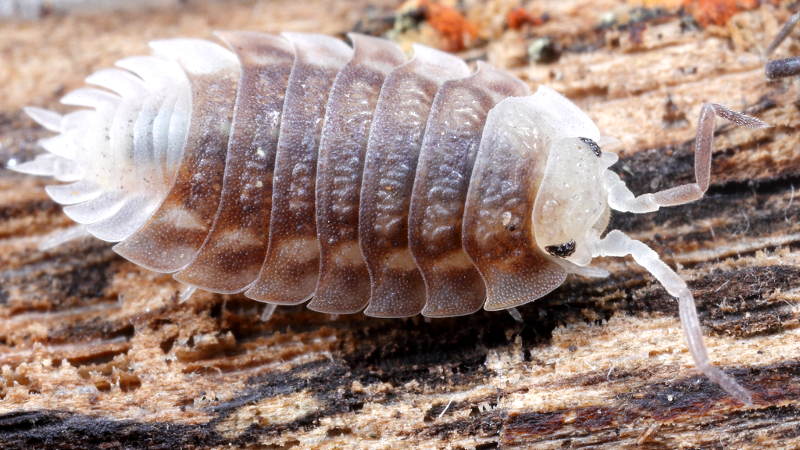
Common Shiny Woodlouse, Oniscus asellus, multicoloured
Striped Woodlouse, Philoscia muscorum
The Striped Woodlouse (Philoscia muscorum) is highly shiny, with dark median line and dark head. The species is extremely fast
(is never indoors).
On 2 may 2012, I find an albino individual in the nature reserve Metbroekbosch in Smeerling.
There is a large variation in color in this species, as you can see on the different pictures.
A reasonably fixed characteristic is the yellow dot on the back of the dark head, but that does not apply to juveniles.

Striped Woodlouse, Philoscia muscorum
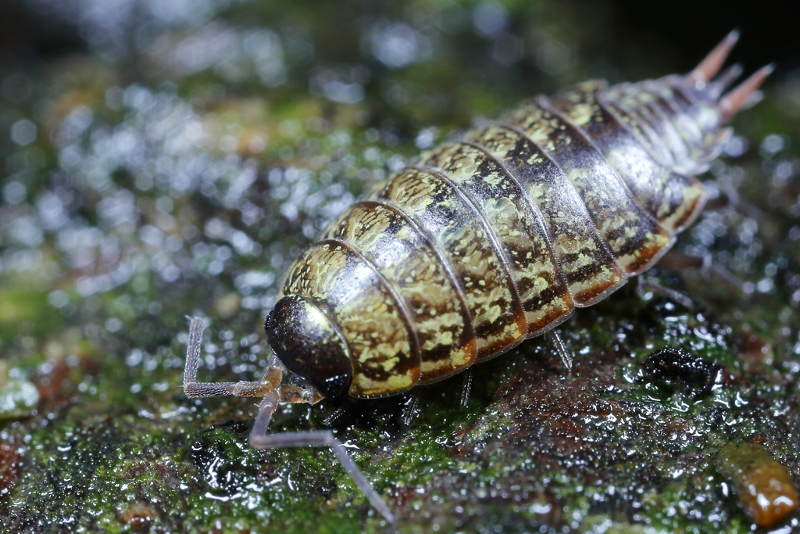
Striped Woodlouse, Philoscia muscorum
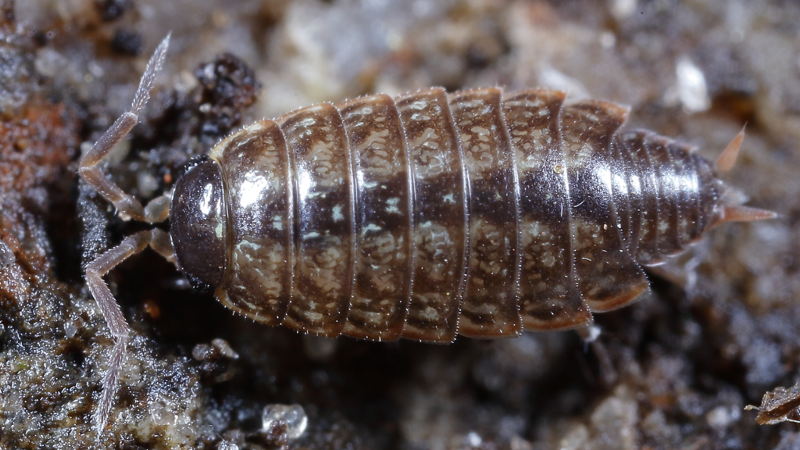
Striped Woodlouse, Philoscia muscorum

Striped Woodlouse, Philoscia muscorum

Striped Woodlouse, Philoscia muscorum, juvenile

Striped Woodlouse, Philoscia muscorum

Striped Woodlouse, Philoscia muscorum

Striped Woodlouse, Philoscia muscorum
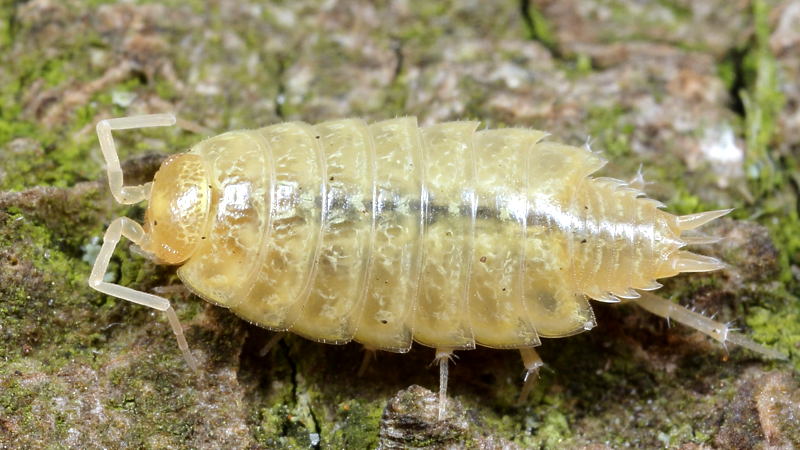
Striped Woodlouse, Philoscia muscorum, albino
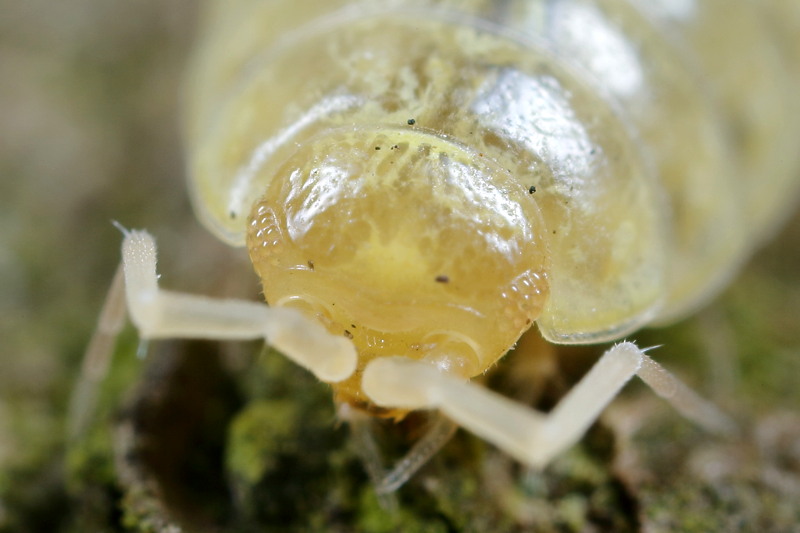
Striped Woodlouse, Philoscia muscorum, albino
Ant Woodlouse, Platyarthrus hoffmannseggii
The Ant Woodlouse Platyarthrus hoffmannseggii is a woodlouse without eyes, found in ants nests. It is a small species of woodlouse that busy moves with his feelers, the way like ants do that. They are also fully accepted by the ants. The animal life of waste from the ants nest. It is a common species, but I didn't not find it much. There lives in ants nests also a springtail, this is also white and blind and moves just like the ants, also this animal is left alone by the ants. Photos and description of the springtail are on the page of the Elongate springtails.
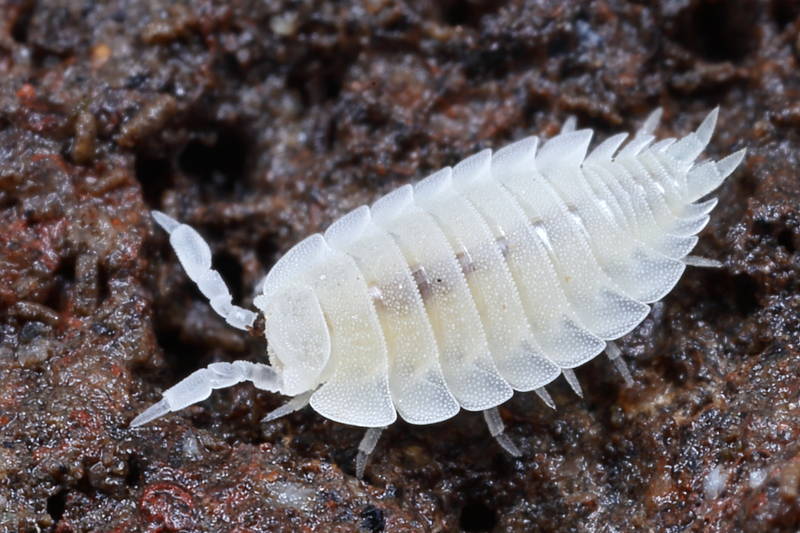
Ant Woodlouse, Platyarthrus hoffmannseggii
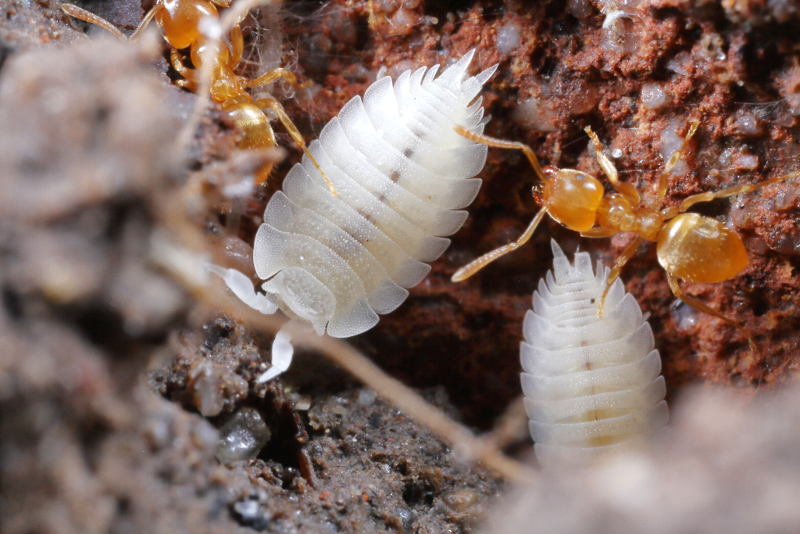
Ant Woodlouse, Platyarthrus hoffmannseggii
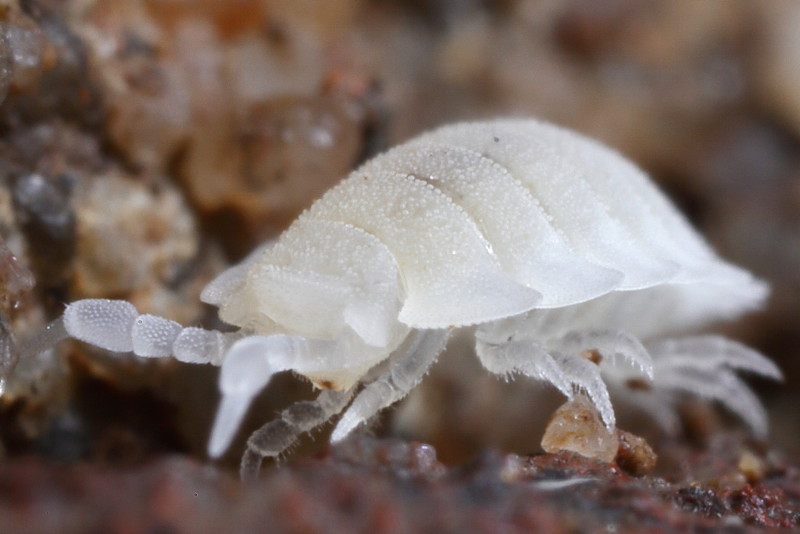
Ant Woodlouse, Platyarthrus hoffmannseggii

Ant Woodlouse, Platyarthrus hoffmannseggii
Woodlouse, Porcellio dilatatus
The Woodlouse, Porcellio dilatatus is a rare species with a preference for warm, stony, cave-like environments that occurs in The Netherlands in particular in (cellars of) buildings of old masonry and in warm greenhouses, but in Zuid-Limburg also in more natural conditions at the entrance of caves and along chalk grasslands. They don't seem to like modern construction materials and virtually do not appear in modern buildings. This species is very wide and greyish red brown in color. They resemble a wide formed Porcellio scaber (but less color variable) and in form on a Oniscus asellus, but which is much smoother and noticeably different colored and spotted. It is best also to this species of looking at the telson, (the rear piece of the tail), the point is clear stump rounded. At species that look alike, the telson is pointed. The lateral lobes (rags under the eyes) stitches far forward, go beyond at the Porcellio scaber, but similar to the Oniscus asellus The frontal lobe ("nose") is similar to the Porcellio scaber and so become quite unlike the Oniscus asellus (there interrupted). The whole impression of the animal is a wide, flat Woodlouse without much drawing.
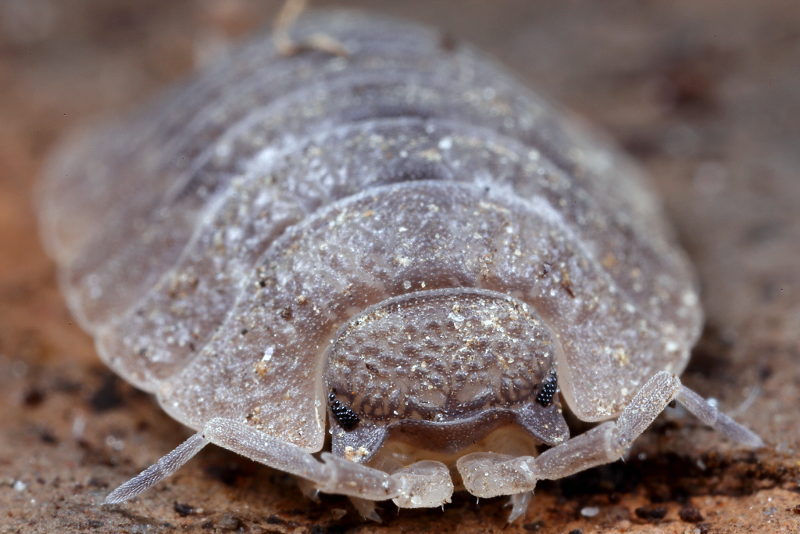
Woodlouse, Porcellio dilatatus
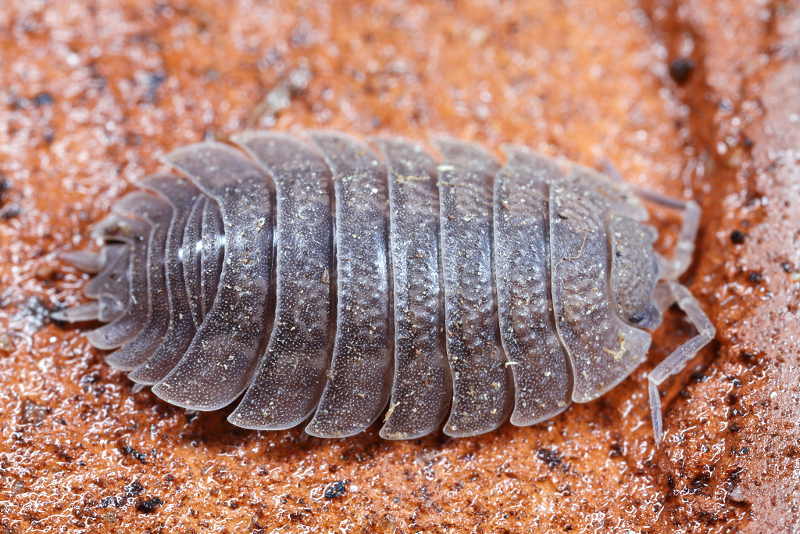
Woodlouse, Porcellio dilatatus
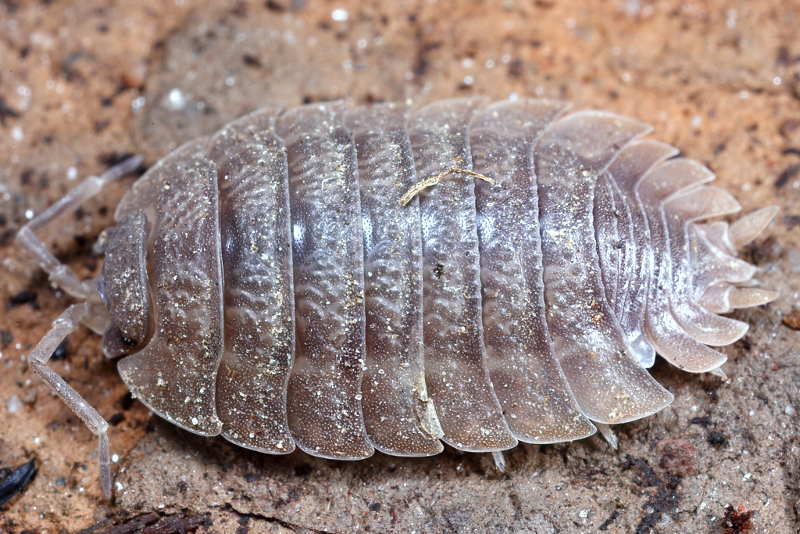
Woodlouse, Porcellio dilatatus
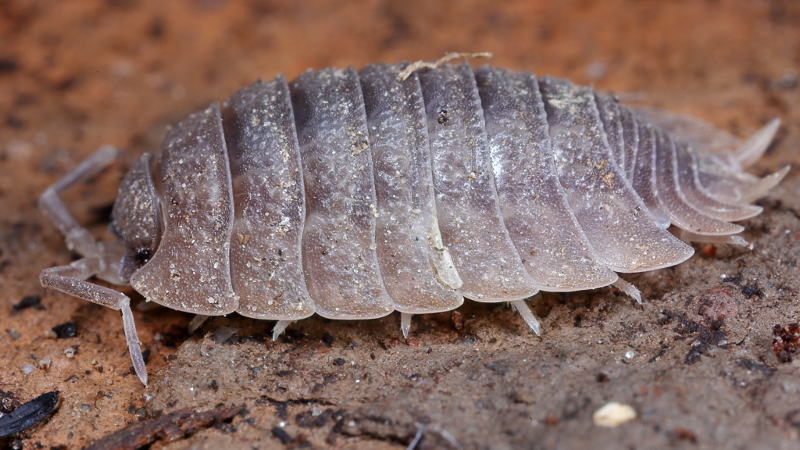
Woodlouse, Porcellio dilatatus
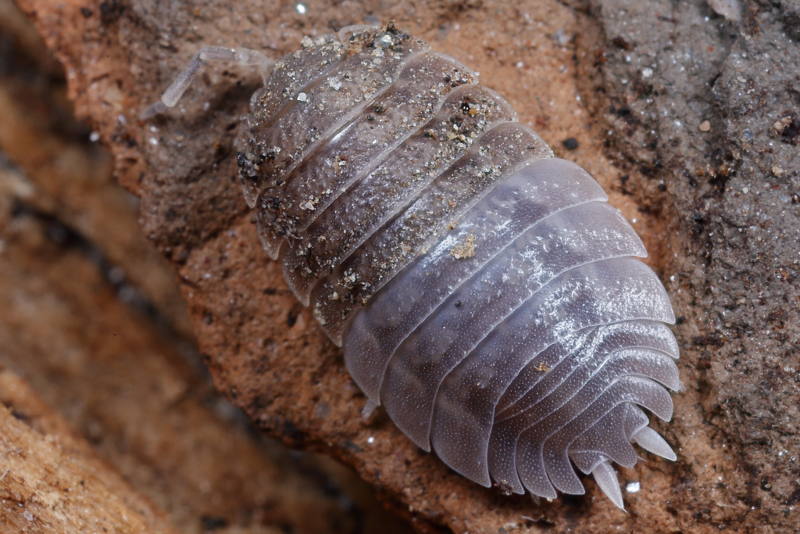
Woodlouse, Porcellio dilatatus
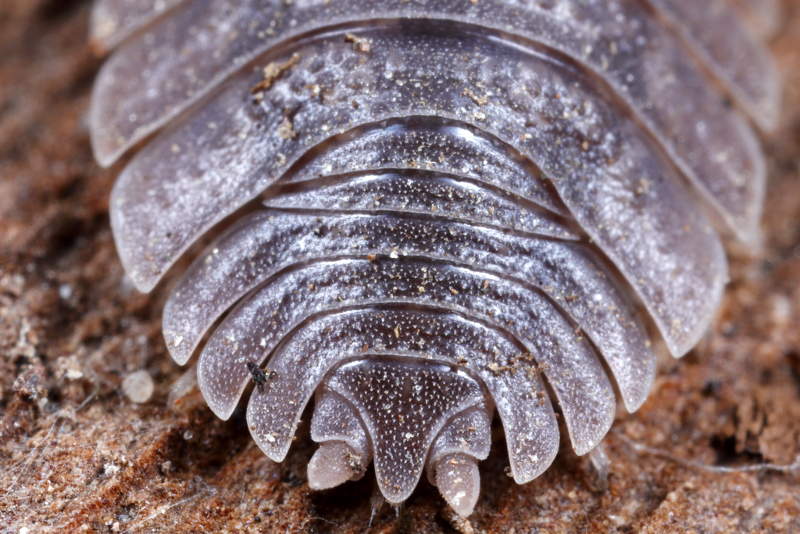
Woodlouse, Porcellio dilatatus
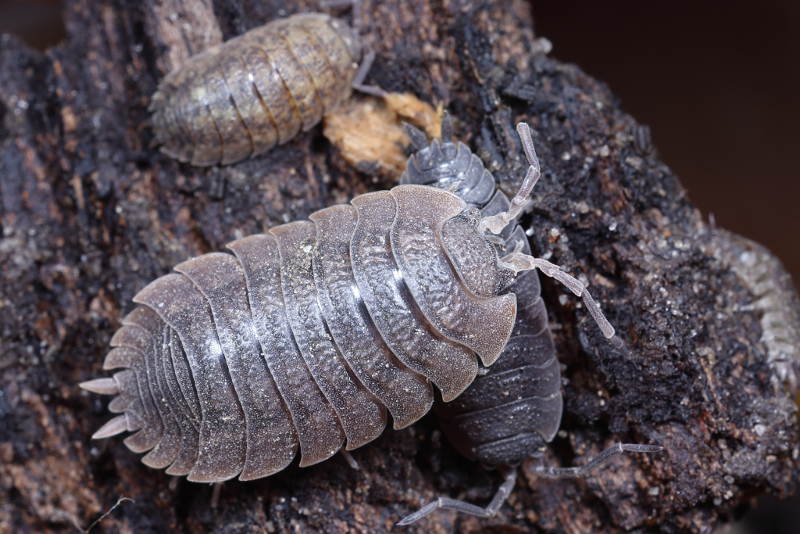
Woodlouse with two Porcellio scaber to compare
Woodlouse, Porcellio laevis
Really smooth is the Woodlouse, Porcellio laevis It is a rare species in quarries and on old buildings in some places in Limburg. The species is heat-loving and is further known from a few greenhouses. The animal of the photo is found by Arp.
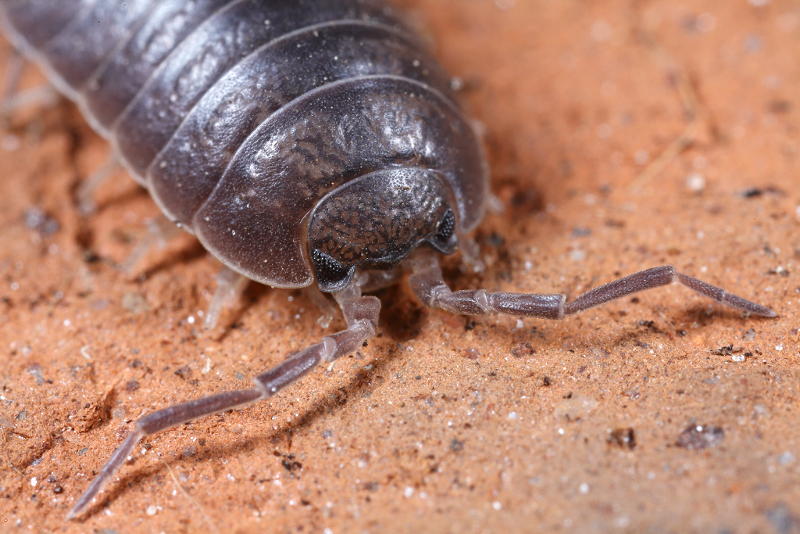
Woodlouse, Porcellio laevis
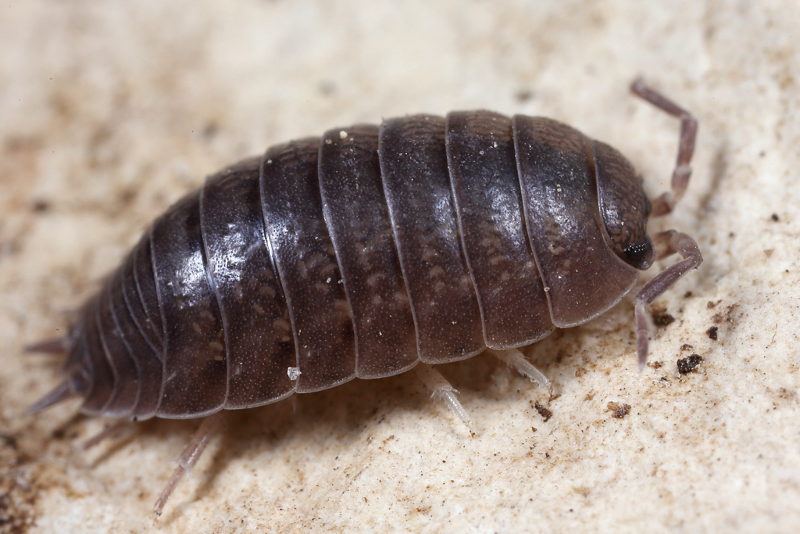
Woodlouse, Porcellio laevis

Woodlouse, Porcellio laevis
Rough Woodlouse, Porcellio scaber
The Rough Woodlouse (Porcellio scaber) is also really rough, You can clearly feel the lumps on top with your finger. Usually the color is dark, sometimes light. On the pictures, different colors of rough woodlice. Nice colored animals are females, the genetic information for the color is on the sex chromosome, colored males can not occur.
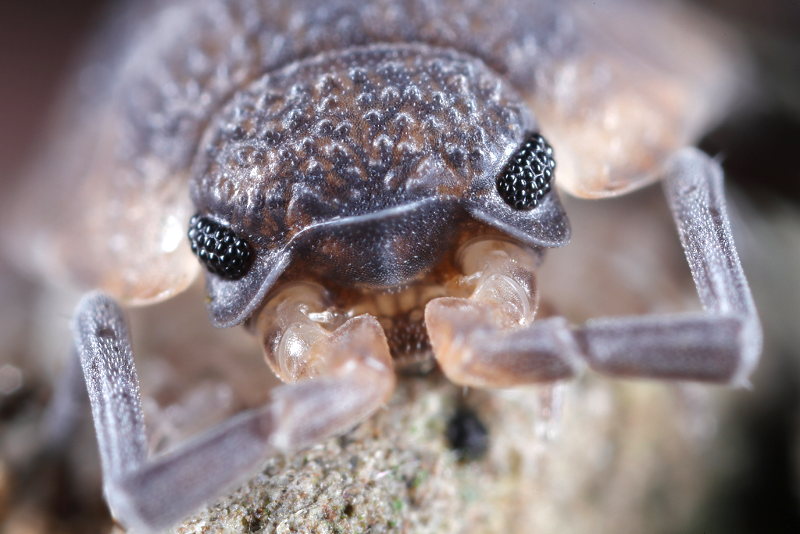
Rough Woodlouse, Porcellio scaber
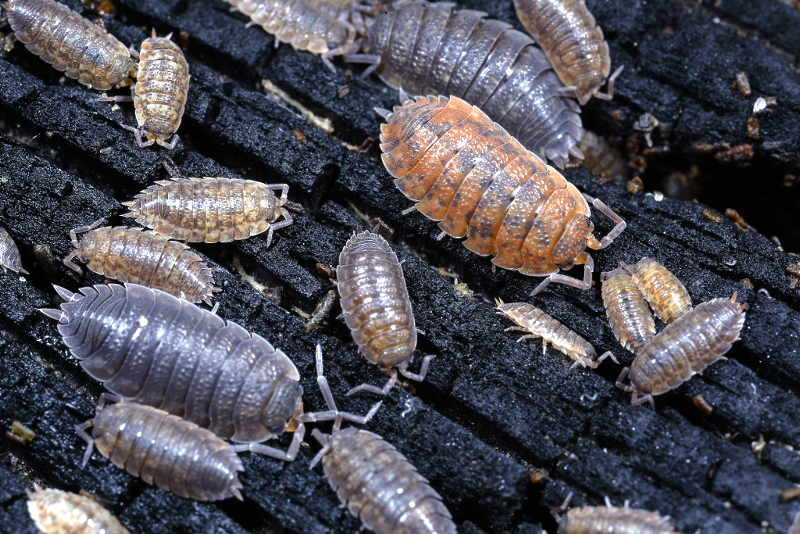
Rough Woodlice, Porcellio scaber
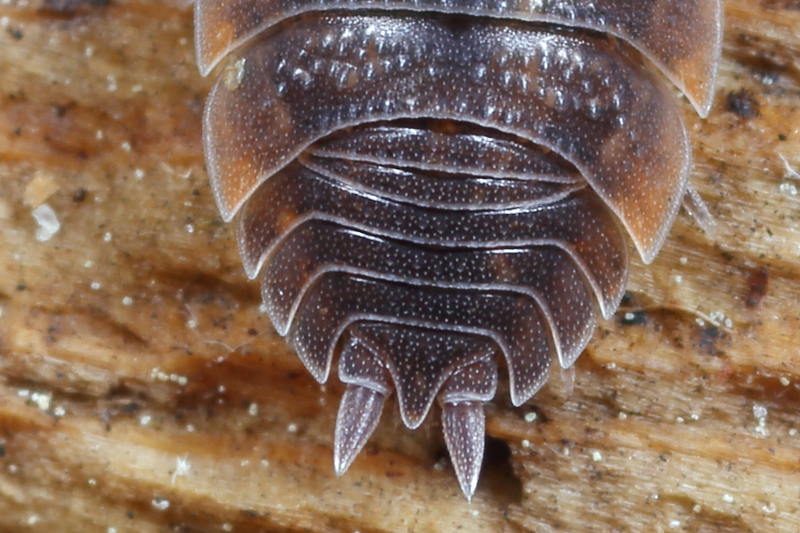
Rough Woodlouse, Porcellio scaber
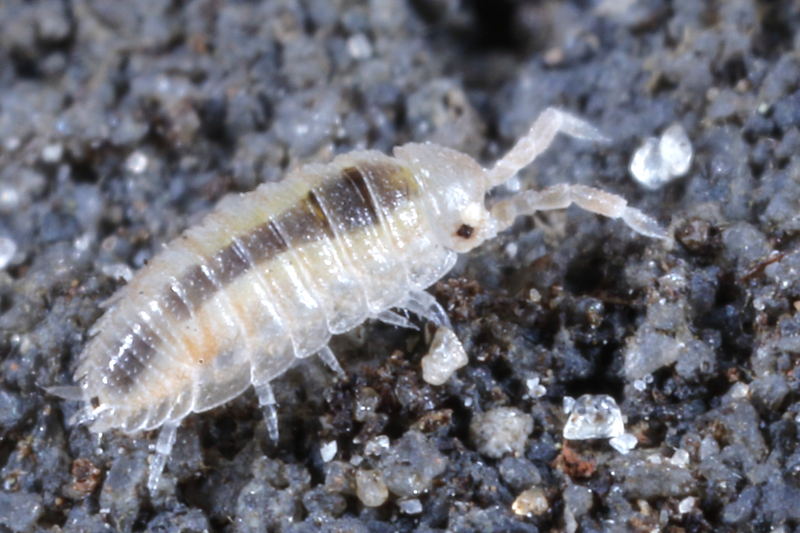
Rough Woodlouse, Porcellio scaber Manca stadium
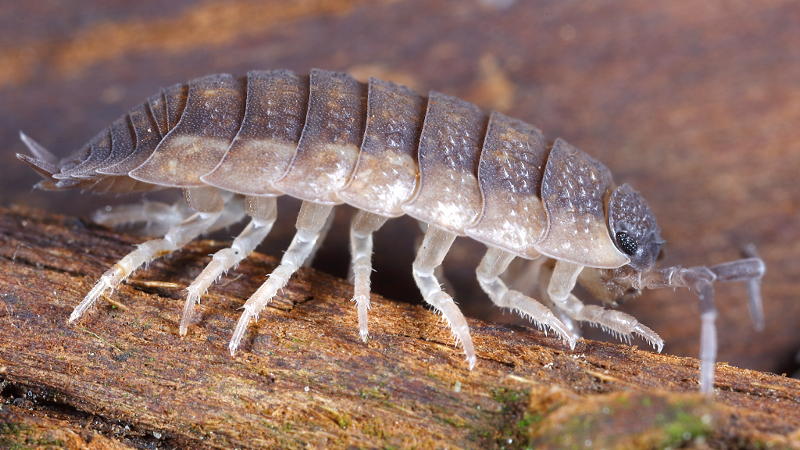
Rough Woodlouse, Porcellio scaber
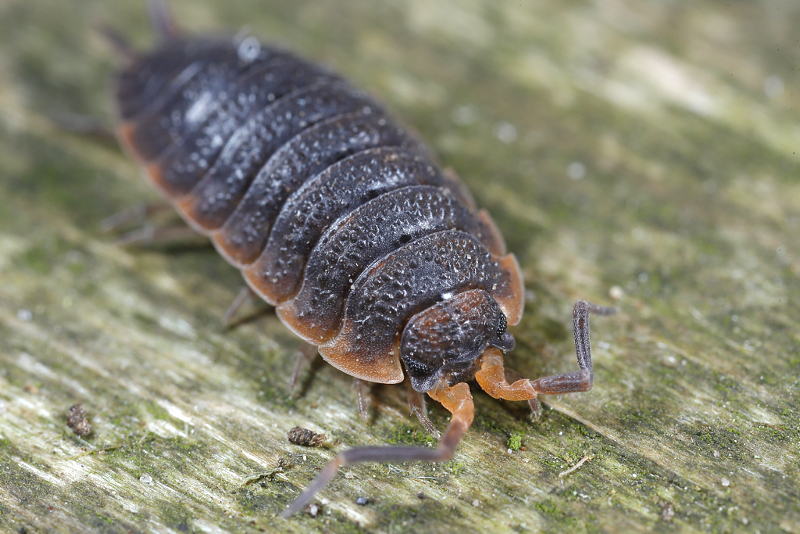
Rough Woodlouse, Porcellio scaber
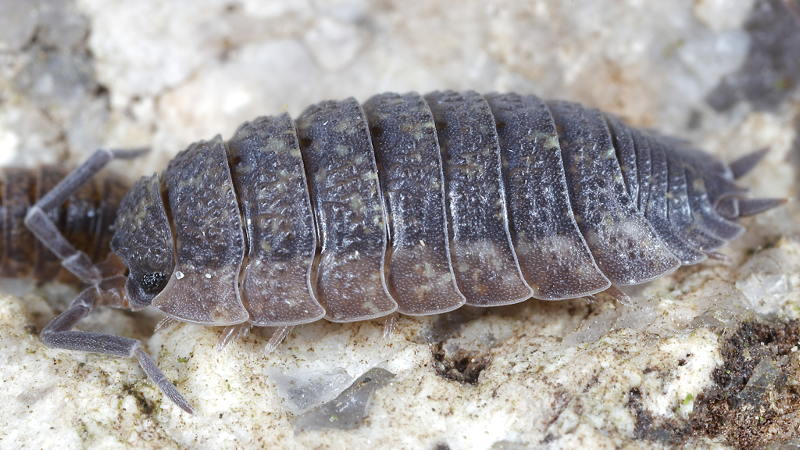
Rough Woodlouse, Porcellio scaber
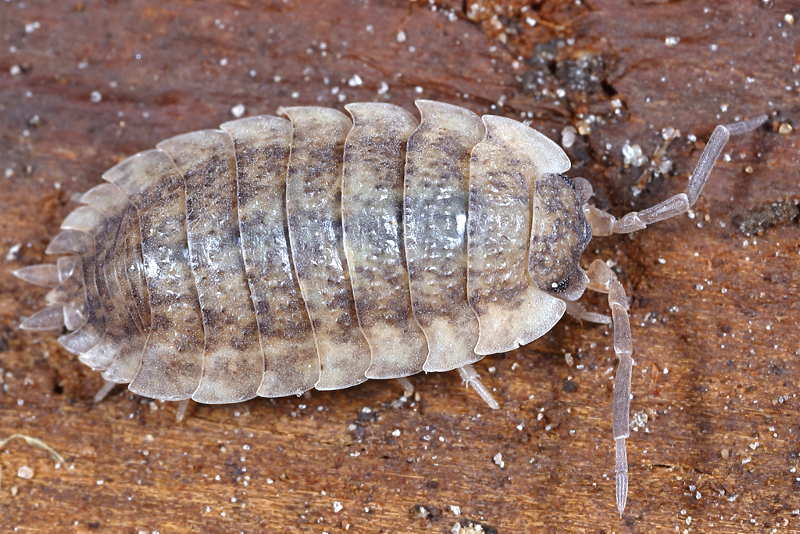
Rough Woodlouse, Porcellio scaber
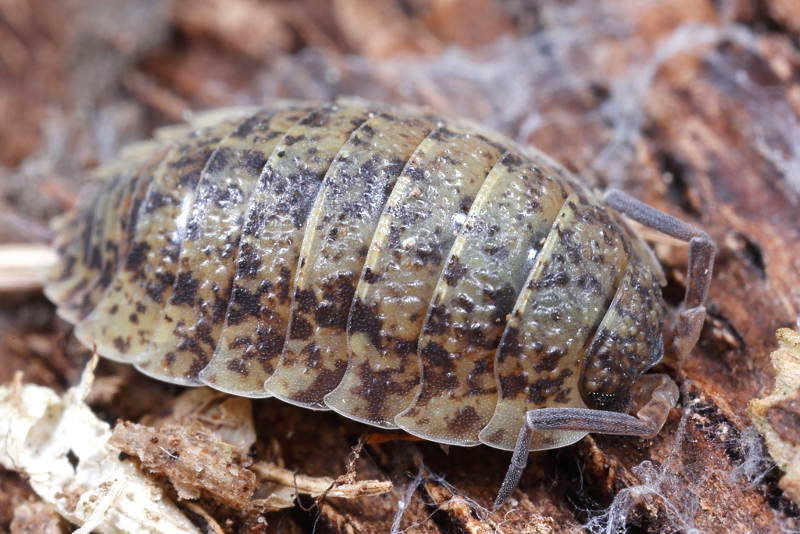
Rough Woodlouse, Porcellio scaber

Rough Woodlouse, Porcellio scaber

Rough Woodlouse, Porcellio scaber

Rough Woodlouse, Porcellio scaber
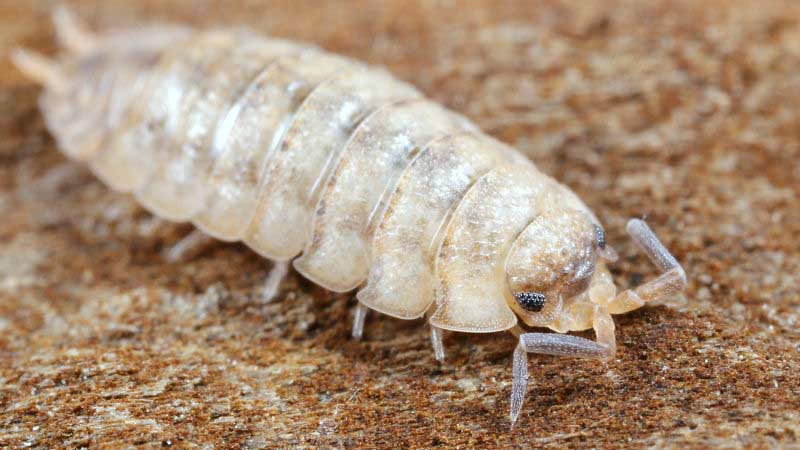
Rough Woodlouse, Porcellio scaber
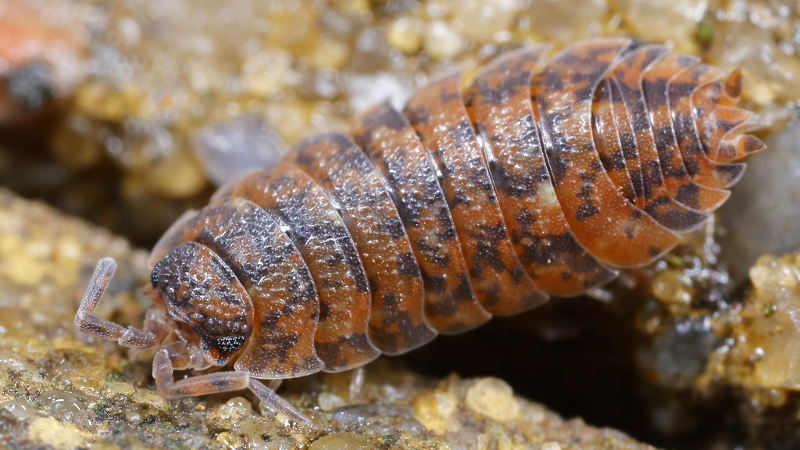
Rough Woodlouse, Porcellio scaber
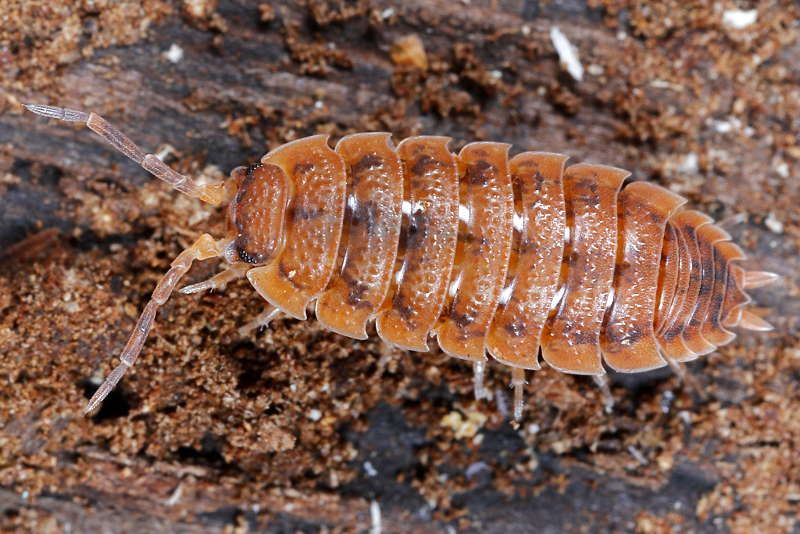
Rough Woodlouse, Porcellio scaber
Below some pictures of an animal that I found in a nature reserve. It is a kind of albino where the grey pigment is missing. The eyes of this animal are red.

Rough Woodlouse, Porcellio scaber

Rough Woodlouse, Porcellio scaber

Rough Woodlouse, Porcellio scaber
Painted Woodlouse, Porcellio spinicornis
Porcellio spinicornis can be recognised by the black head and also the tail is darker than the body. On the back are two rows of yellow spots that are regularly divided. Usually you can find them on walls and buildings, it is a heat loving species. This species is often confused with the Striped Woodlouse, which shines much more, is much faster and the dark tail is missing.
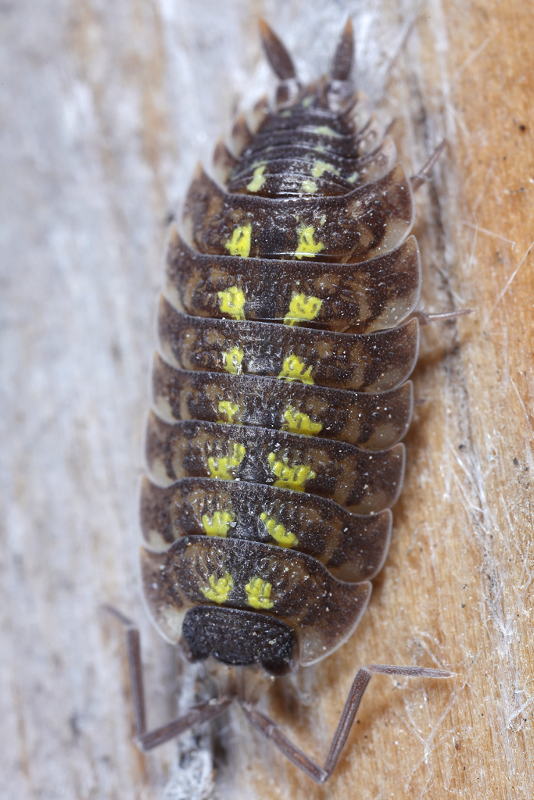
Painted Woodlouse, Porcellio spinicornis
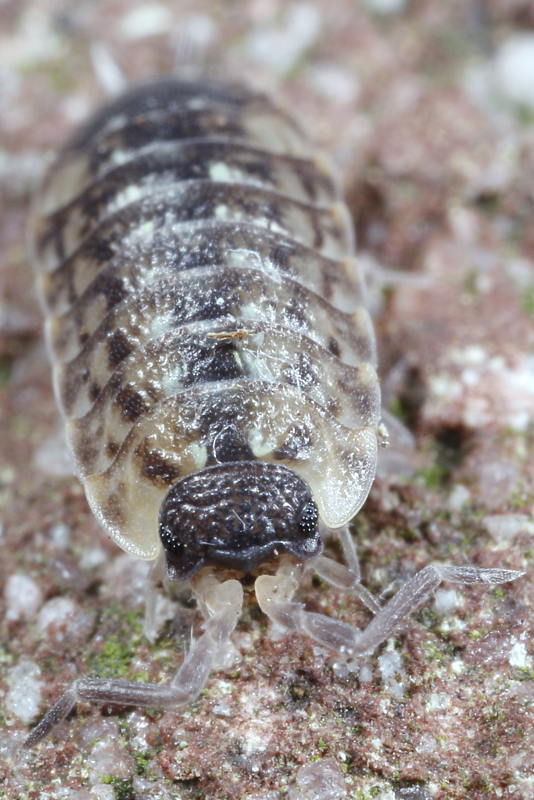
Painted Woodlouse, Porcellio spinicornis

Painted Woodlouse, Porcellio spinicornis
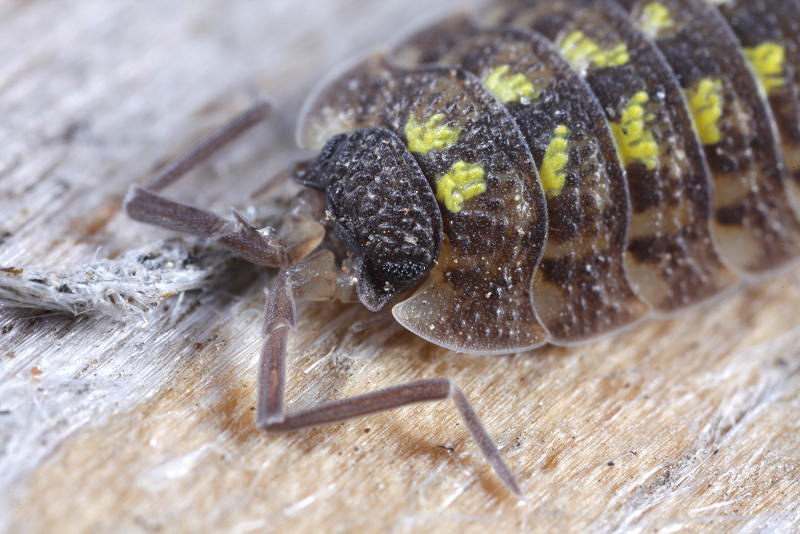
Painted Woodlouse, Porcellio spinicornis
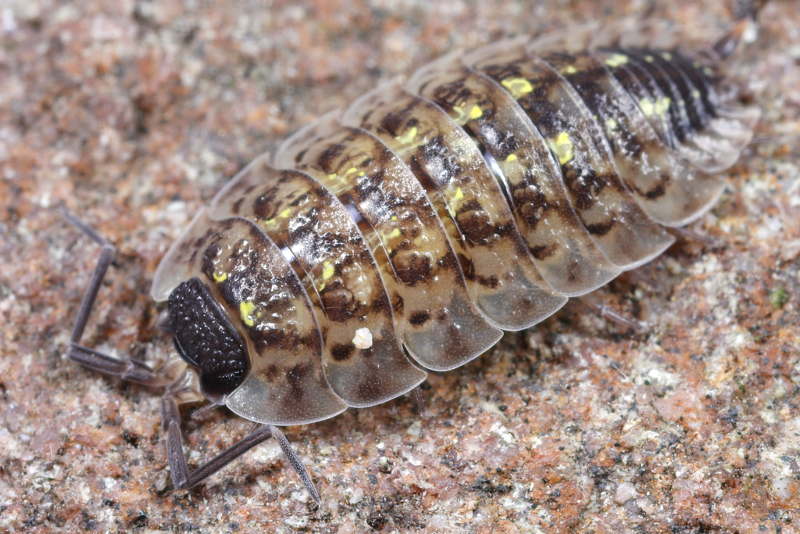
Painted Woodlouse, Porcellio spinicornis
Plum Woodlouse, Porcellionides pruinosus
Porcellionides pruinosus a very rare species in The Netherlands, it is a heat loving species Characteristic are the white legs, the frosted body and white rings to the antennas. The behavior makes you think of a Striped Woodlouse, but this species is still much faster. You will find them in tropical greenhouses, on compost heaps and manure heaps where is heat by scalding.
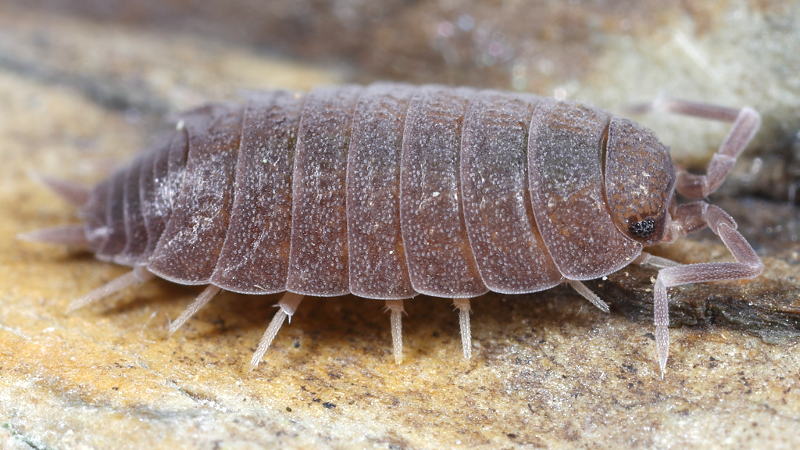
Plum Woodlouse, Porcellionides pruinosus
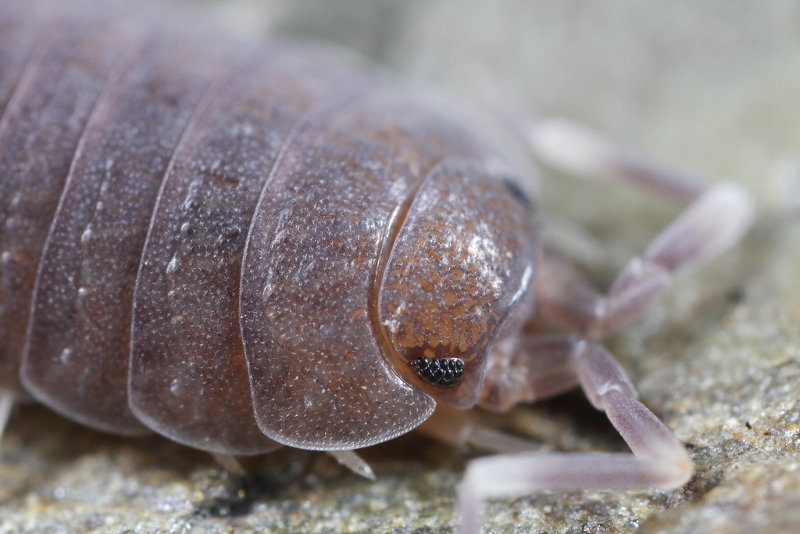
Plum Woodlouse, Porcellionides pruinosus
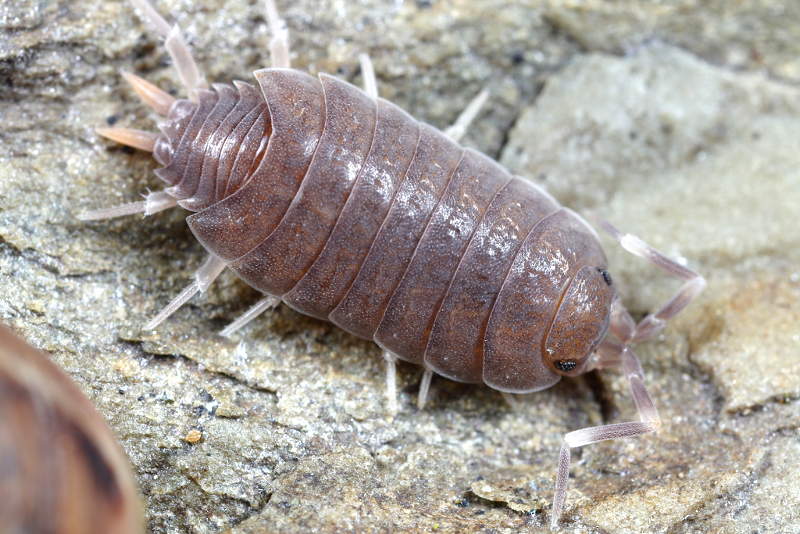
Plum Woodlouse, Porcellionides pruinosus
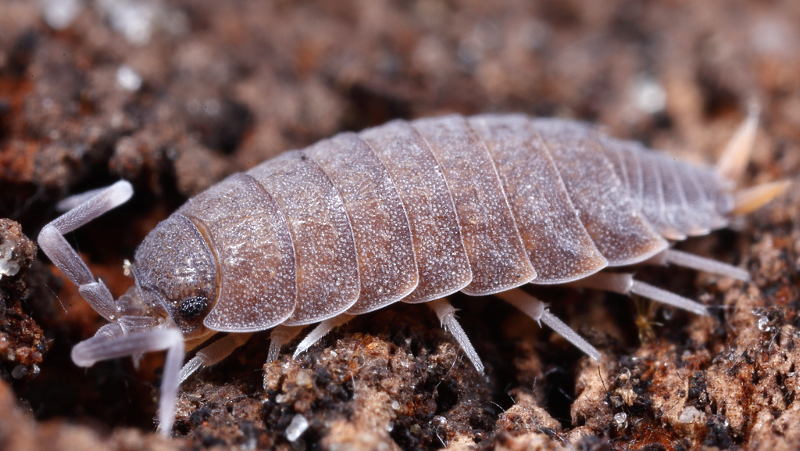
Plum Woodlouse, Porcellionides pruinosus

Plum Woodlouse, Porcellionides pruinosus
Stebbing's Woodlouse, Cordioniscus stebbingi
Stebbing's Woodlouse, Cordioniscus stebbingi belongs to the greenhouse species and you don't see it outside It is a small species of woodlouse about 3 mm. With an eye on both sides consisting of three ocelli. In the greenhouses where it occurs it can be found in large numbers. Also this animal was found by Arp.
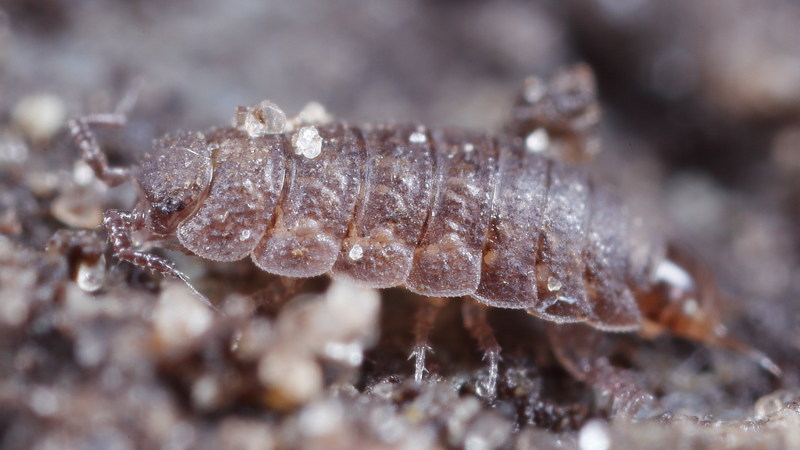
Stebbing's Woodlouse, Cordioniscus stebbingi
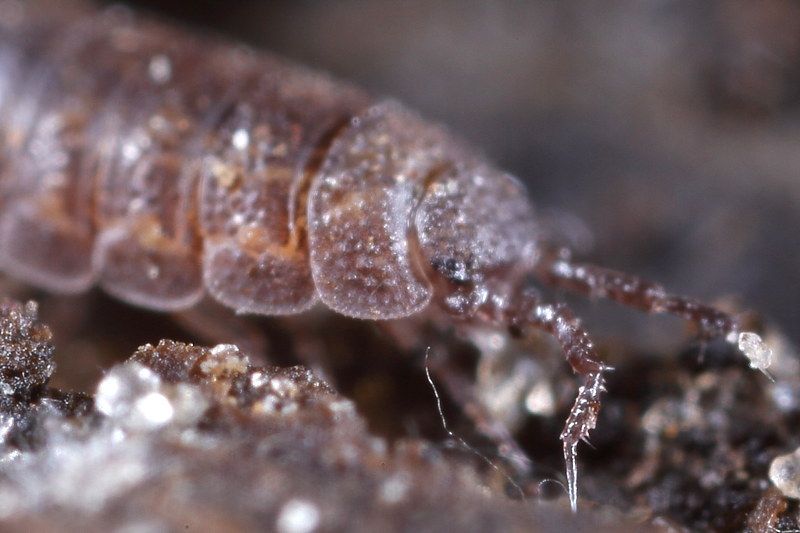
Stebbing's Woodlouse, Cordioniscus stebbingi
Woodlouse, Nagurus cristatus
The Woodlouse Nagurus cristatus is a species from all tropical areas and is in The Netherlands found in tropical greenhouses. It is known from several zoos and greenhouses in the west of the country. It is quite possible that it also occurs elsewhere in greenhouses but not everywhere one pays attention to woodlice. Like the other indoor/greenhouse species it is not likely that it can survive outside.

Woodlouse, Nagurus cristatus
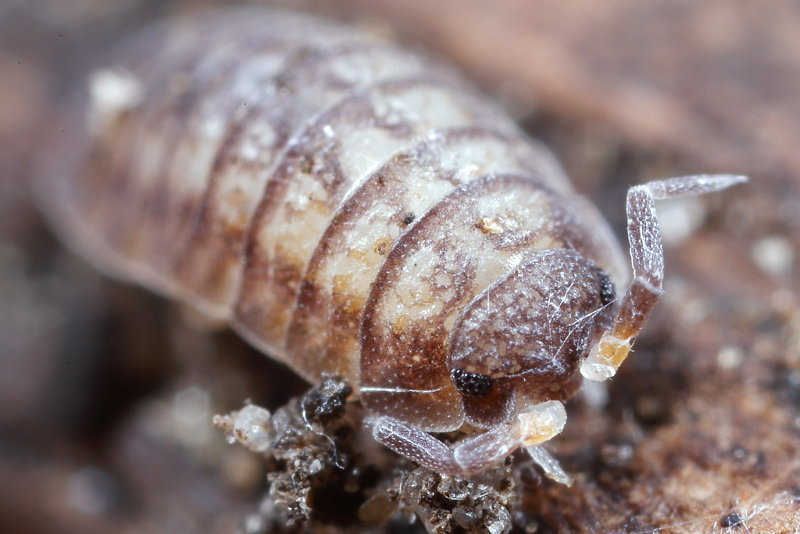
Woodlouse, Nagurus cristatus
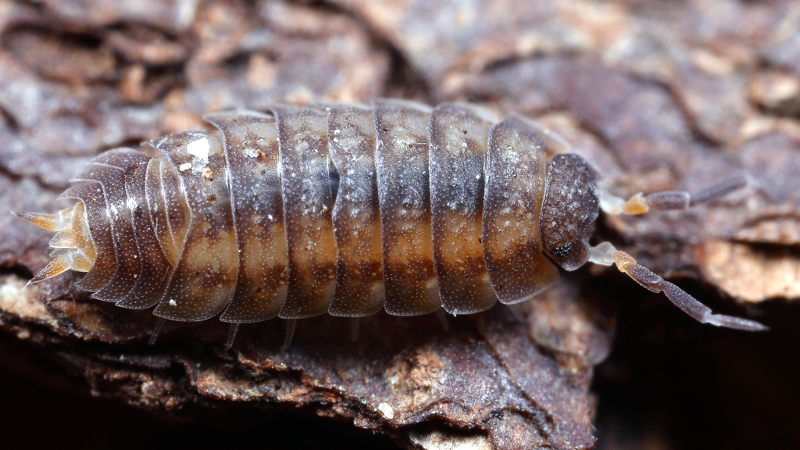
Woodlouse, Nagurus cristatus
Woodlouse, Porcellium conspersum
This species of woodlouse is up to 8.5 mm long, one of the smaller species.
They look a lot like a small Rough Woodlouse, or a juvenile Common Shiny Woodlouse.
he telson, the last piece of the tail, is very broad rounded and the uropod (the tail appendices next to it)
are very short, barely longer than the telson. In many similar-looking species the telson is extending much more to behind.
The antennas are remarkably short and sturdy.
In the event of danger they can roll up to almost a ball,
hence, the appendices should be short, so they are rolling away at disturbance.
The ball is not as perfect as the real Roll-up Pill Bugs.
Also Porcellium has just like Trachelipus, pleopodal lungs on the bottom of all five abdominal segments.
In the field you can badly see all these attributes without loupe, but the animals stand out instantly because most
colour forms are somewhat light, orange-red or whitish marbled, with a thin but conspicuous black edge along the contour.
Only at the darker indivudials this is not immediately striking.
In Rough Woodlouse such marbled color forms also occure, but usually without the black edge.
Along with Arp I went looking for the Porcellium conspersum.
It is a rare species of very moist forests and we look for it in a forest on the other side of the channel than where
he previous was encountered.
There was very little rain in recent weeks and the drainage ditch along the forest is dry.
At the bottom of the ditch we are looking between the moist old leaves.
We find much Ligidium hypnorum, Oniscus asellus, one Haplophthalmus danicus,
Philoscia muscorum, but no Porcellium conspersum.
Then Arp goes looking between the decayed leaf on the high edge of the ditch shore.
So that's the right place, after ten minutes enthusiastic digging he has found two.
The channel is the channel Almelo-Nordhorn, a no longer used by the shipping, old channel with lots of vegetation and clear water.

Woodlouse, Porcellium conspersum
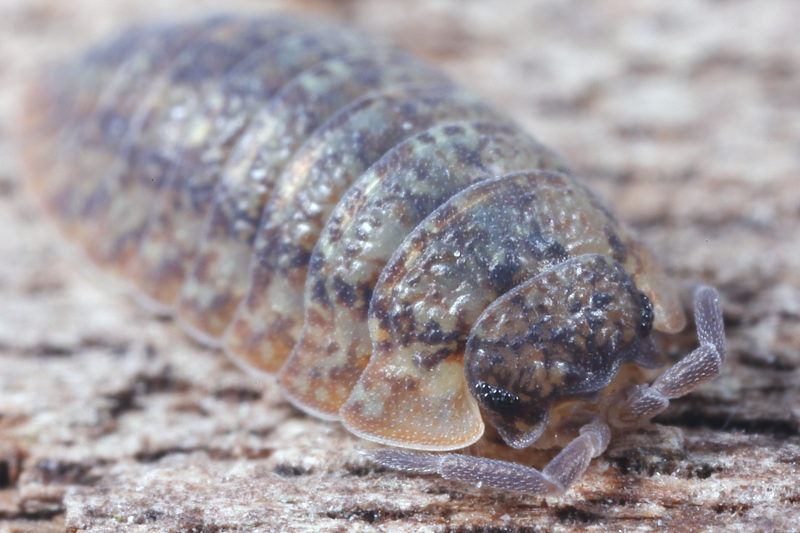
Woodlouse, Porcellium conspersum
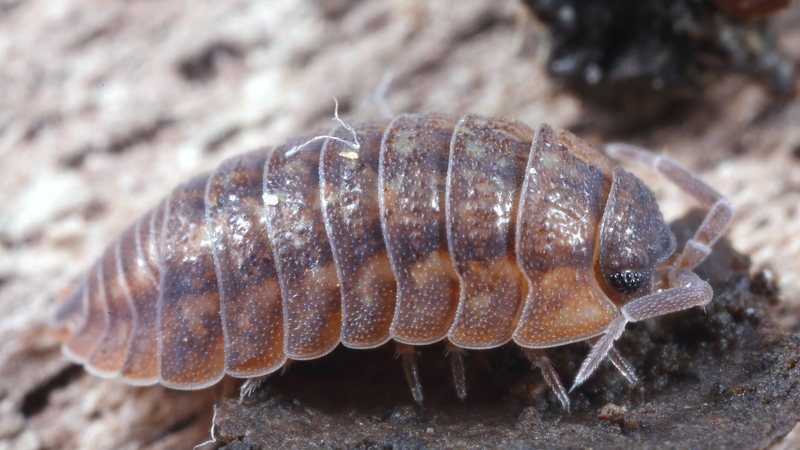
Woodlouse, Porcellium conspersum

Woodlouse, Porcellium conspersum
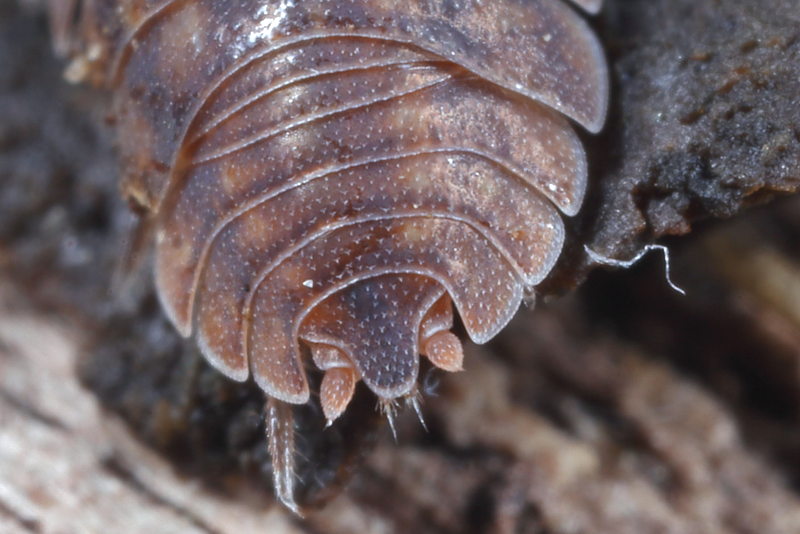
Woodlouse, Porcellium conspersum
Rathke's Woodlouse, Trachelipus rathkii
A large species of woodlouse that you often encounter on the clay is Trachelipus rathkii. On the sandy soil in the forest near me I have seen it only once. It is not a rare species. The species pretty much resembles a Porcellio scaber but has spots that are in rows.
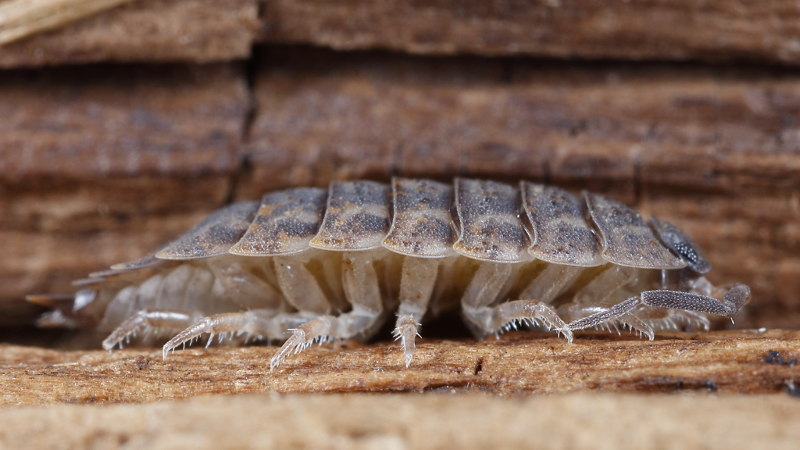
Rathke's Woodlouse, Trachelipus rathkii
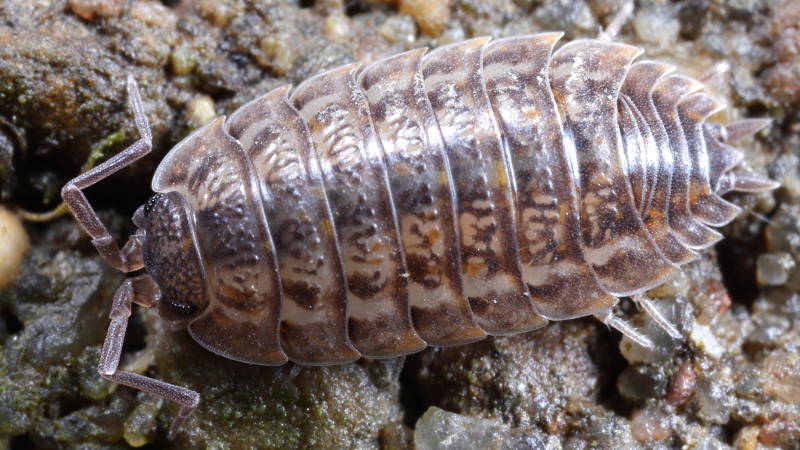
Rathke's Woodlouse, Trachelipus rathkii
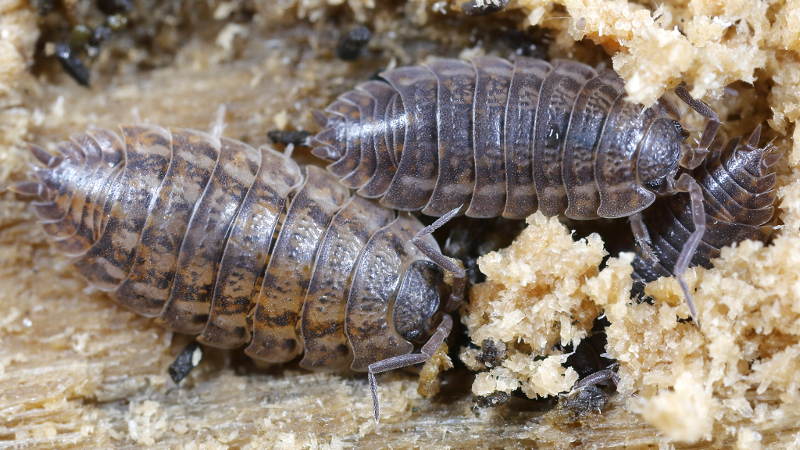
Rathke's Woodlouse, Trachelipus rathkii
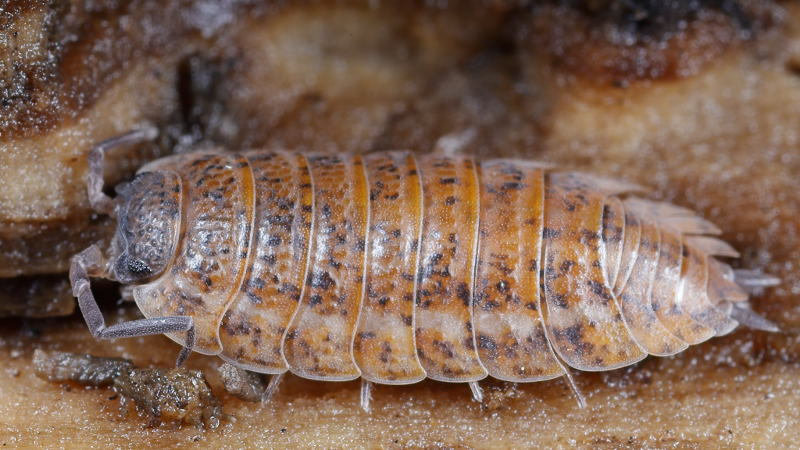
Rathke's Woodlouse, Trachelipus rathkii
Rosy Woodlouse, Androniscus dentiger
Of the woodlice, I think this is the most colourful, most are grey or brown in all kinds of gradations, this one is really beautiful bright pink/red in color with yellow stripes on the back behind. The English name is well chosen Rosy Woodlouse. The eye consists of one ommatidium. It is a small species of woodlouse, about 6 mm and it is rare. Arp Kruithof had found it before in Maastricht and there it still sat when we went there 09-08-2013 to search. In the damp clay at the foot of an ancient defensive wall of the city.
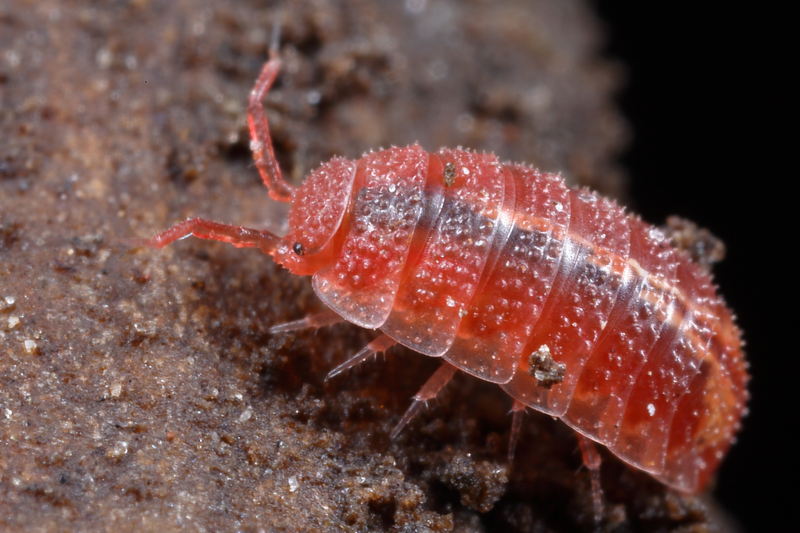
Rosy Woodlouse, Androniscus dentiger
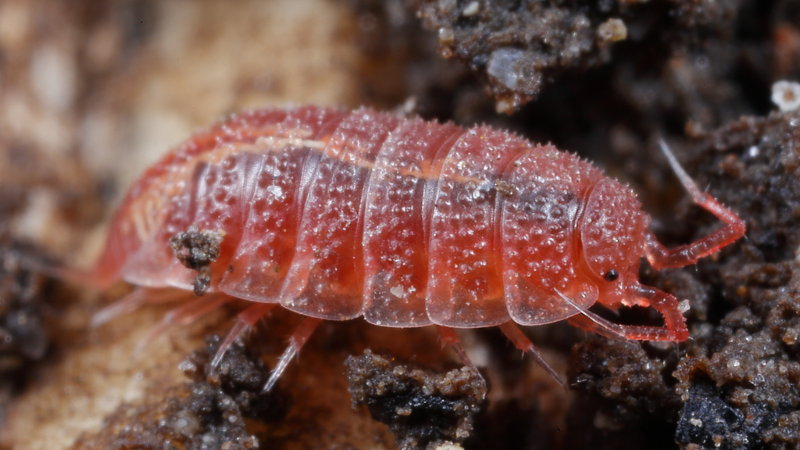
Rosy Woodlouse, Androniscus dentiger

Rosy Woodlouse, Androniscus dentiger

Rosy Woodlouse, Androniscus dentiger
Spurred Ridgeback, Haplophthalmus danicus
The Spurred Ridgeback Haplophthalmus danicus is also a small species of woodlouse, up to more than 4 mm.
This Spurred Ridgeback sat under a piece of very wet bark that was lying on the ground next to the firewood pile.
Identification characteristics by Matty Berg:
On the third segment of the last five body segments, the tailpiece or pleon, is at the top no lump visible.
That is the case with H. mengii and H. montivagus. Further just one dark ocellus on each side and the ridges are arranged lengthwise.

Spurred Ridgeback, Haplophthalmus danicus
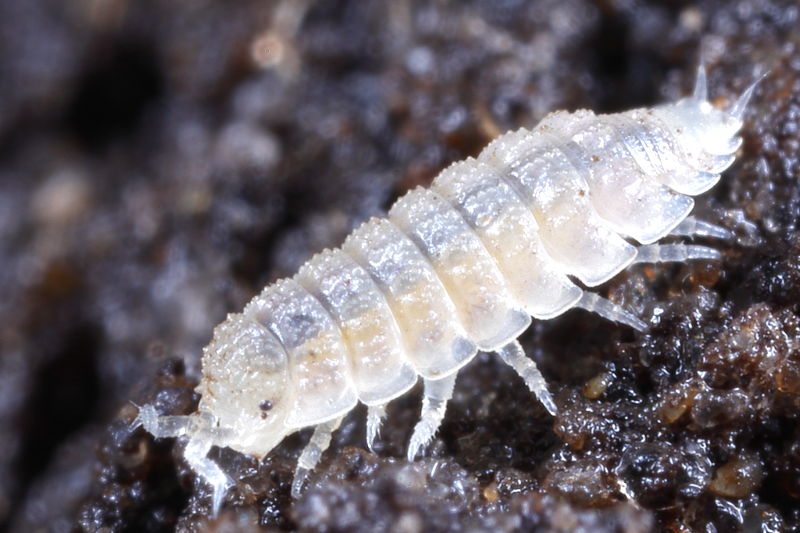
Spurred Ridgeback, Haplophthalmus danicus

Spurred Ridgeback, Haplophthalmus danicus
Common Ridgeback, Haplophthalmus mengei
The Common Ridgeback, Haplophthalmus mengei is slightly smaller than the Spurred Ridgeback, is up to 4 mm. It is an animal that can be found on the clay. Under a deep in the soil lying dike stone sat this animal in the sea clay of Groningen. They can also be found in River clay. The big difference with the Spurred Ridgeback are the two nubs on the third segment of the tailpiece (pleon). On the back segments are clear length ridges, the Spurred Ridgeback has rows of nodules.

Common Ridgeback, Haplophthalmus mengei

Common Ridgeback, Haplophthalmus mengei
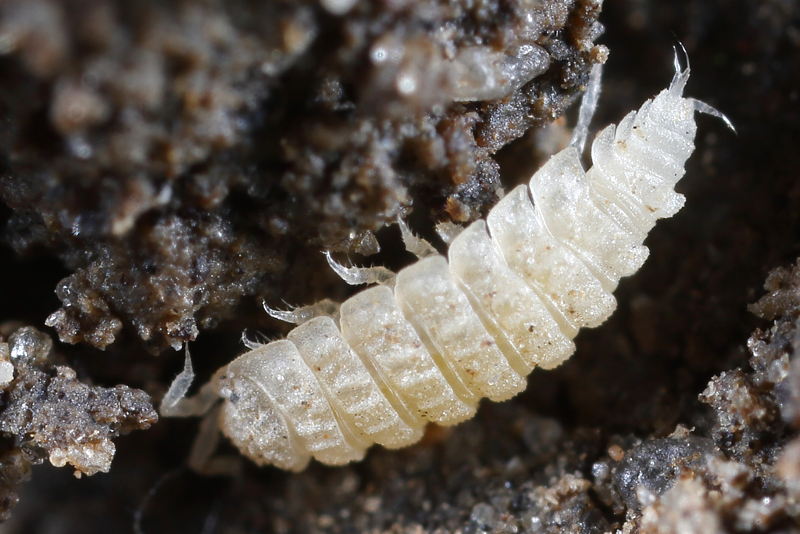
Common Ridgeback, Haplophthalmus mengei
Southern Ridgeback, Haplophthalmus montivagus
The Southern Ridgeback Haplophthalmus montivagus is indistinguishable from the Common Ridgeback Haplophthalmus mengei from a photo, you must look at the male genitalia. The attached picture was taken on the banks of the Meuse in Eijsden the only place in the Netherlands where it is shown.
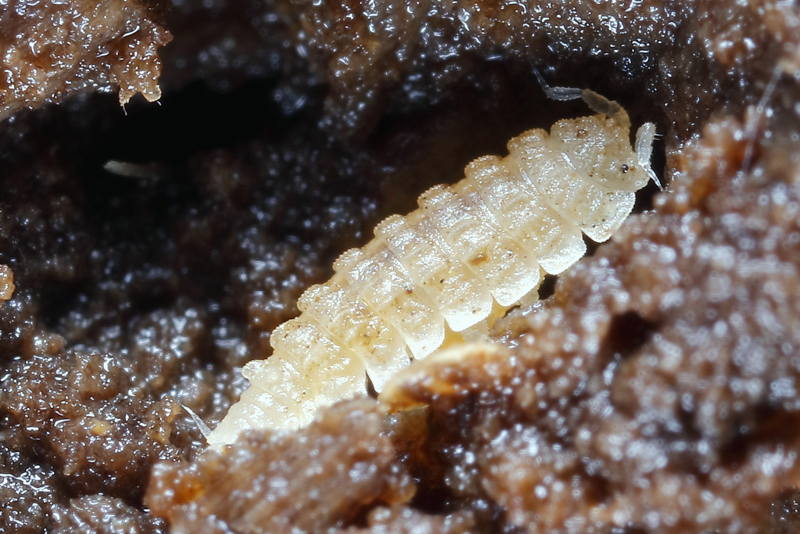
Southern Ridgeback, Haplophthalmus montivagus
Woodlouse, Hyloniscus riparius
A small reddish Woodlouse is the Woodlouse, Hyloniscus riparius. At this little animal the eye does not exist from three but from a single ocellus. The species I find in Zuid-Limburg on the Sint Pietersberg in Maastricht.

Woodlouse, Hyloniscus riparius

Woodlouse, Hyloniscus riparius
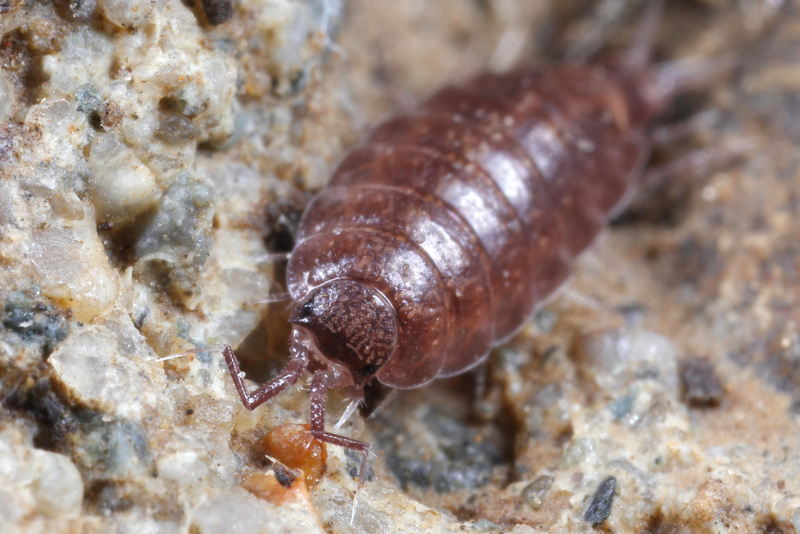
Woodlouse, Hyloniscus riparius
Woodlouse, Metatrichoniscoides leydigii
Metatrichoniscoides leydigii, has no eyes and is completely white. The body is rough, there are pimples on the back. On the picture you can see a dark line in the middle on the back, that's the gut which is visible through the skin.
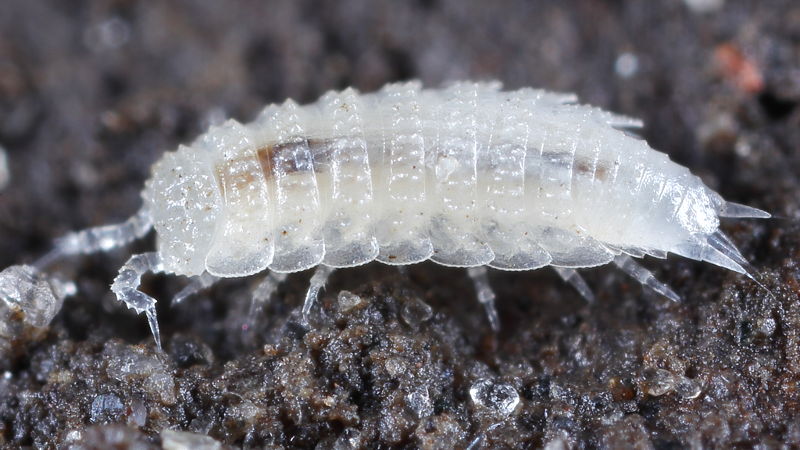
Woodlouse, Metatrichoniscoides leydigii
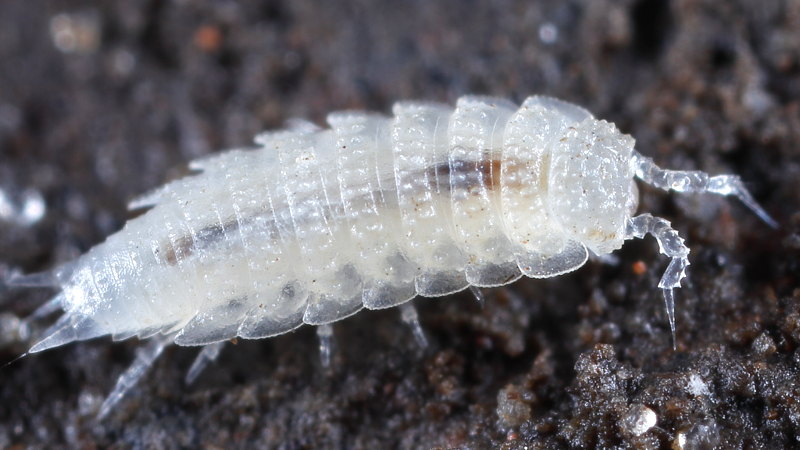
Woodlouse, Metatrichoniscoides leydigii

Woodlouse, Metatrichoniscoides leydigii
Coastal Black-eye, Miktoniscus patiencei
The Coastal Black-eye, Miktoniscus patiencei is a very small species of woodlouse. The animal on the photos was found by Matty Berg at a depth of about 1 meter under large stones. The species is rare and occurs in The Netherlands only along the North Sea coast of Zeeuws Vlaanderen and along the South coast of Walcheren and Zuid-Beveland on the Westerschelde. The animal is all white with a single black ocel. The dark stripe on the body is the intestinal tract, the color may vary depending on the food taken up. The dots on the body are not rows as with the Haplophthalmus species.
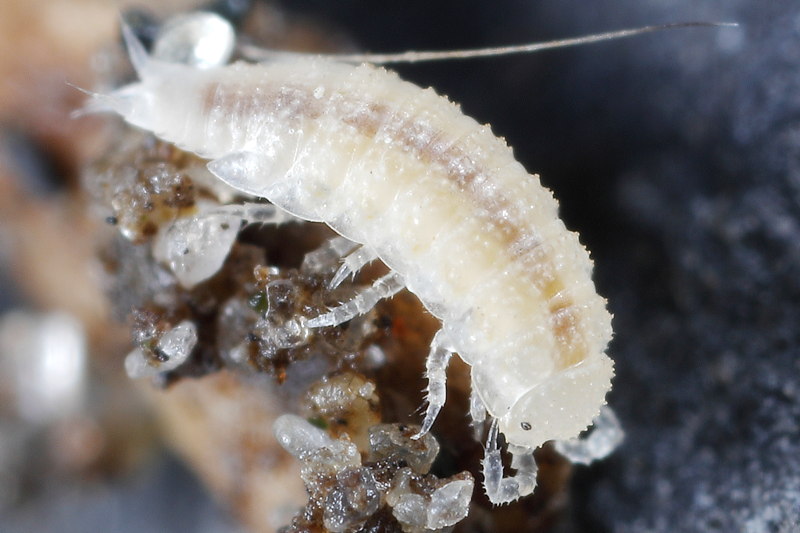
Coastal Black-eye, Miktoniscus patiencei
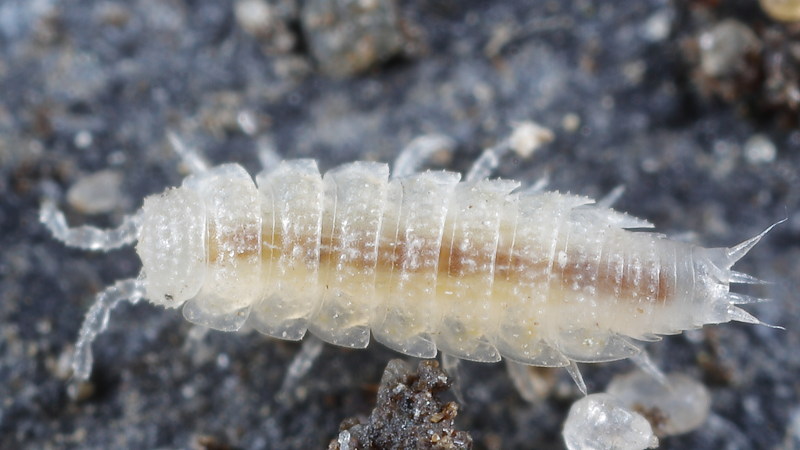
Coastal Black-eye, Miktoniscus patiencei
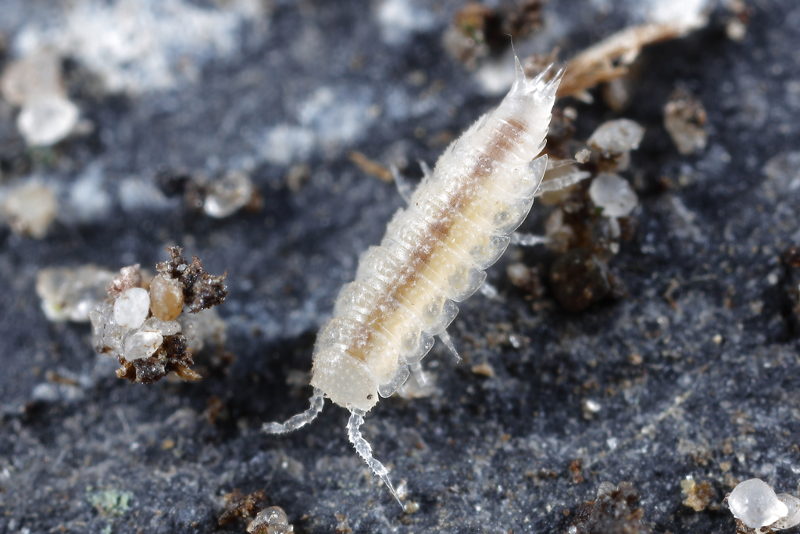
Coastal Black-eye, Miktoniscus patiencei
Rough Pygmy Woodlouse, Trichoniscoides albidus
A small woodlouse that is reminiscent of the Common Pygmy Woodlouse but less smooth and slightly larger. That is the Rough Pygmy Woodlouse, Trichoniscoides albidus. Another difference is, that this species has only one large ocel and Trichoniscus has three. The Rough Pygmy Woodlouse is mainly found on the clay in coastal areas and along the major rivers. The individual on the upper photos I found in the nature reserve de Blauwe Kamer near Rhenen. The bottom two pictures are created in Termunten. he animal is not rare in Netherlands but is little seen. This species is very small, to only 4 mm long.
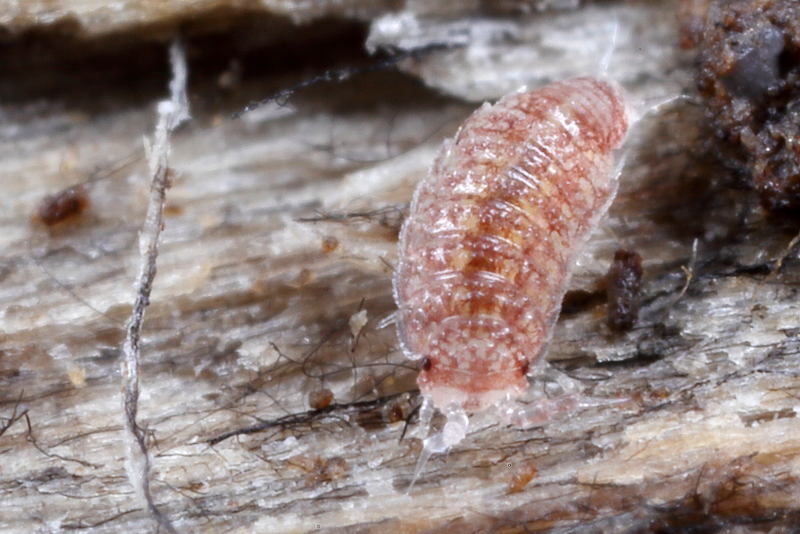
Rough Pygmy Woodlouse, Trichoniscoides albidus
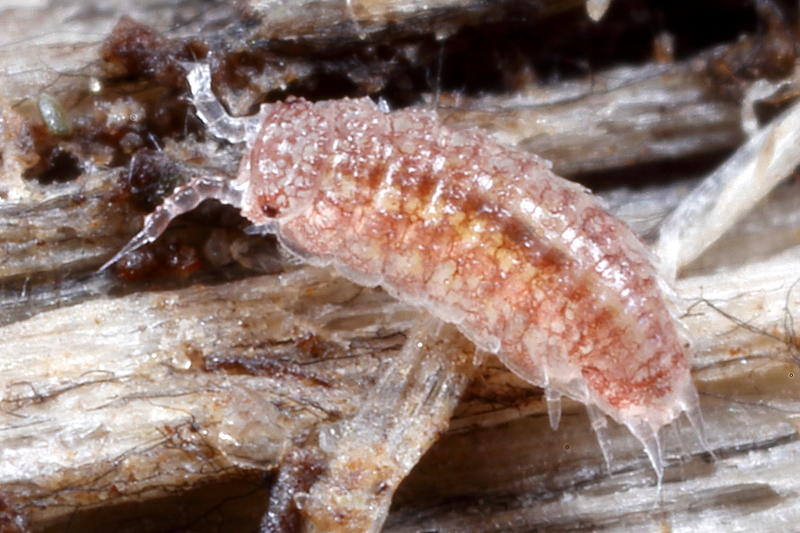
Rough Pygmy Woodlouse, Trichoniscoides albidus

Rough Pygmy Woodlouse, Trichoniscoides albidus

Rough Pygmy Woodlouse, Trichoniscoides albidus
Swiss Red-eye, Trichoniscoides helveticus
The Swiss Red-eye, Trichoniscoides helveticus is small, up to 3.8 mm. Animals of this species have an orange color over the body that can range from hardly present to whole orange. This species is on the outside indistinguishable from the Sars' Red-eye, Trichoniscoides sarsi but it is believed that animals found on sea clay are T.sarsi and animals of River clay areas are T. helveticus. The animal of the photos comes from the Ooijpolder and is so found on River clay. The back is rough because there are pimples, the eye consists of one red colored ocel. See also the Sars' Red-eye.
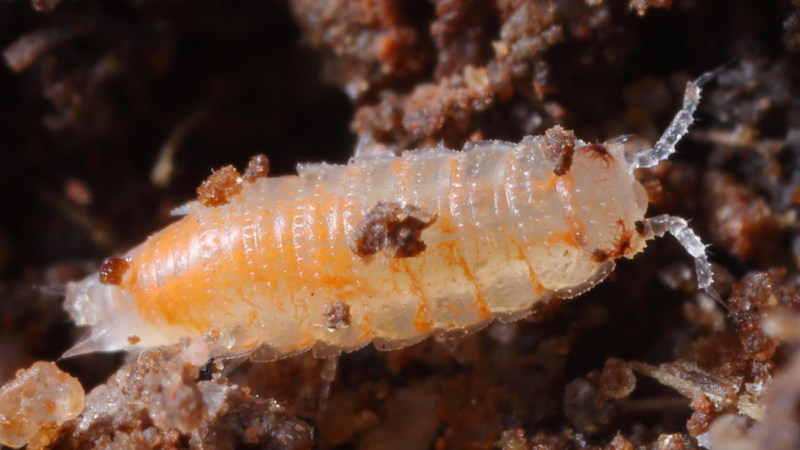
Swiss Red-eye, Trichoniscoides helveticus
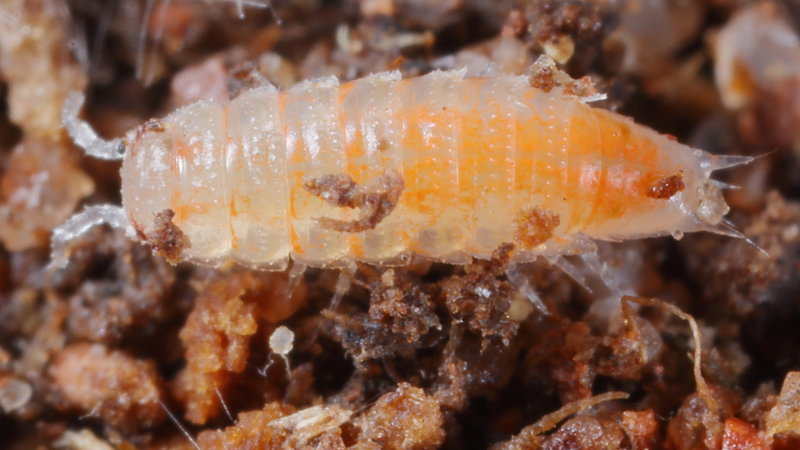
Swiss Red-eye, Trichoniscoides helveticus
Sars' Red-eye, Trichoniscoides sarsi
For description see Swiss Red-eye, the species are indistinguishable on a photo. The animals of the photos were found in a ditch at the shore of the North Sea Canal and at the Dollard dijk, so sea clay.

Sars' Red-eye, Trichoniscoides sarsi
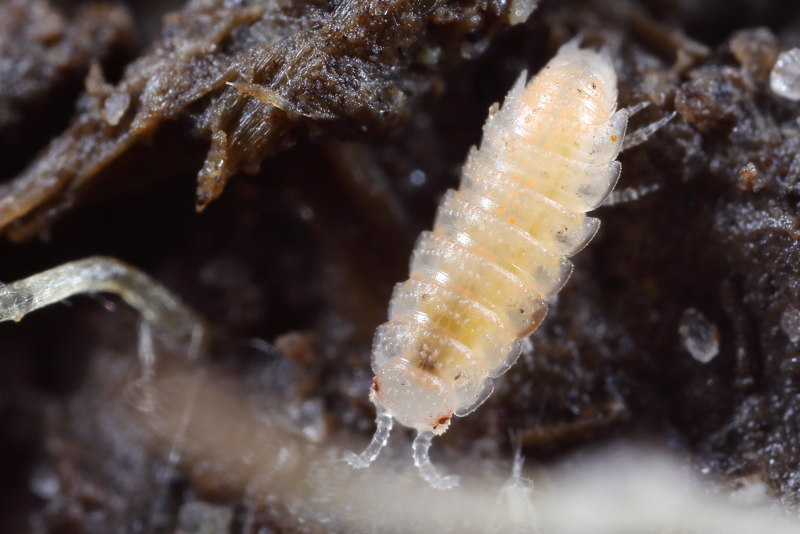
Sars' Red-eye, Trichoniscoides sarsi
Common Pygmy Woodlouse, Trichoniscus pusillus/provisorius
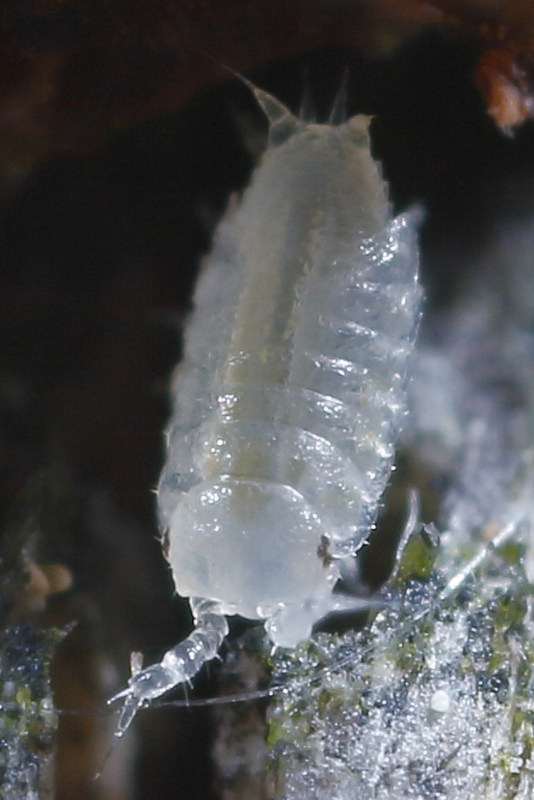
Trichoniscus, early manca phase
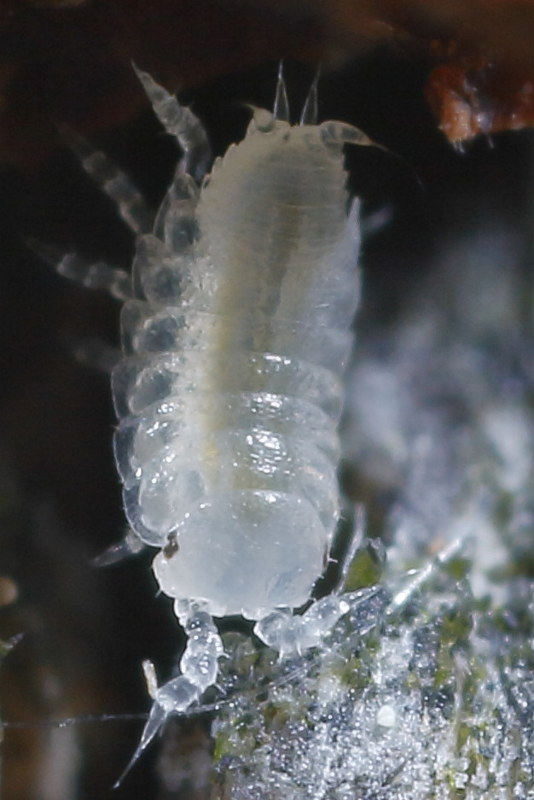
Trichoniscus, early manca phase
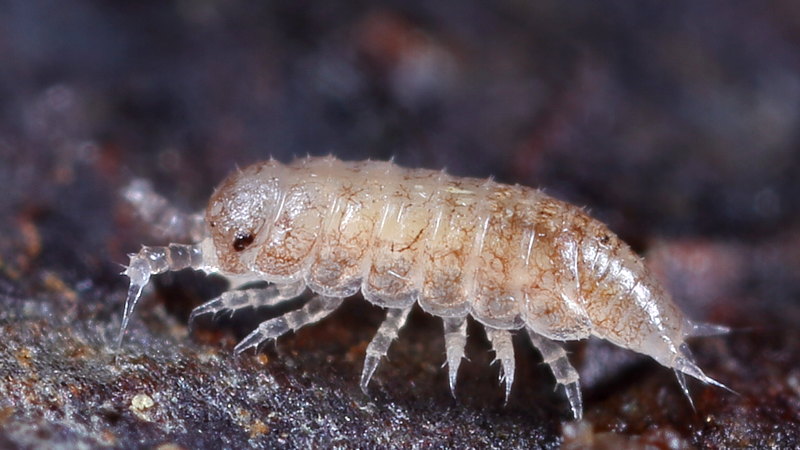
Trichoniscus, manca phase
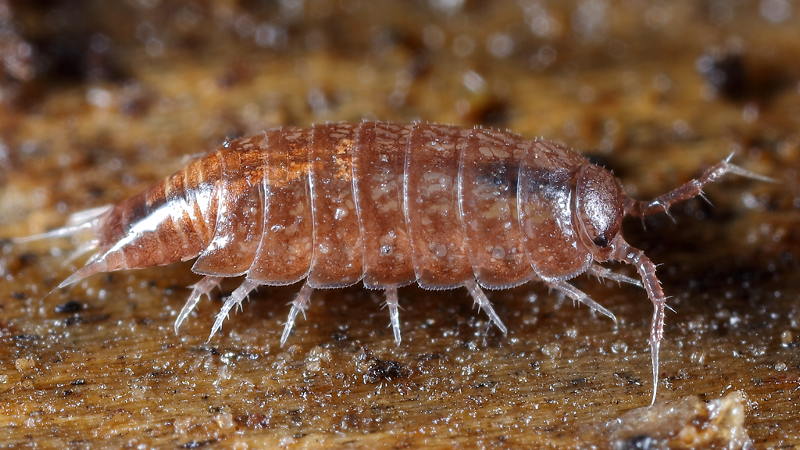
Trichoniscus pusillus/provisorius
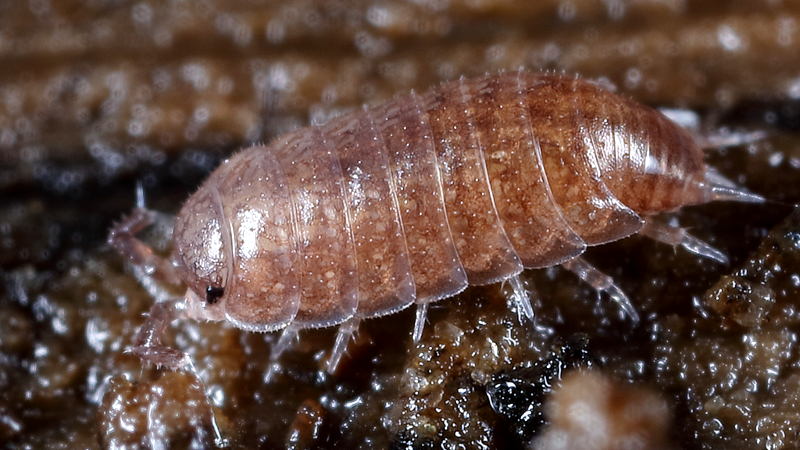
Trichoniscus pusillus/provisorius
The Common Pygmy Woodlouse stand out not much, it is small, purplish brown in color and is on moist places under branches and stones. There are two species of the Common Pygmy Woodlouse, Trichoniscus pusillus en T. provisorius. Unfortunately these two species can be distinguished only on the basis of male reproductive organs.

Common Pygmy Woodlouse, Trichoniscus pusillus/provisorius
Least Pygmy Woodlouse, Trichoniscus pygmaeus
There is another woodlouse with three eyes, the Least Pygmy Woodlouse Trichoniscus pygmaeus that is small, 2.5 mm. The animal on the photos is found in Zaandijk by Matty Berg during an excursion, I got the opportunity to take photos of it. The animals are small and white with a bit of pink touch and yellowish stripes on the back. There are pimples on the back of the animal so that they don't look smooth and there is always something of color present, sometimes much, never quite white.
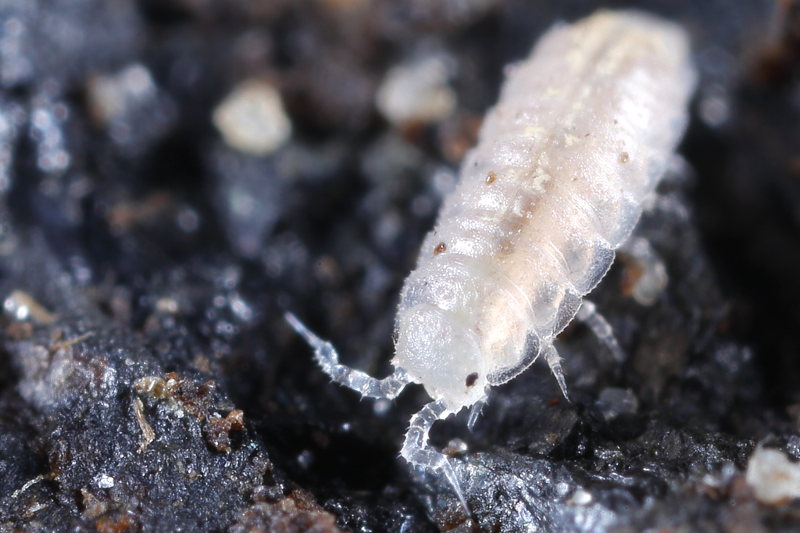
Least Pygmy Woodlouse, Trichoniscus pygmaeus
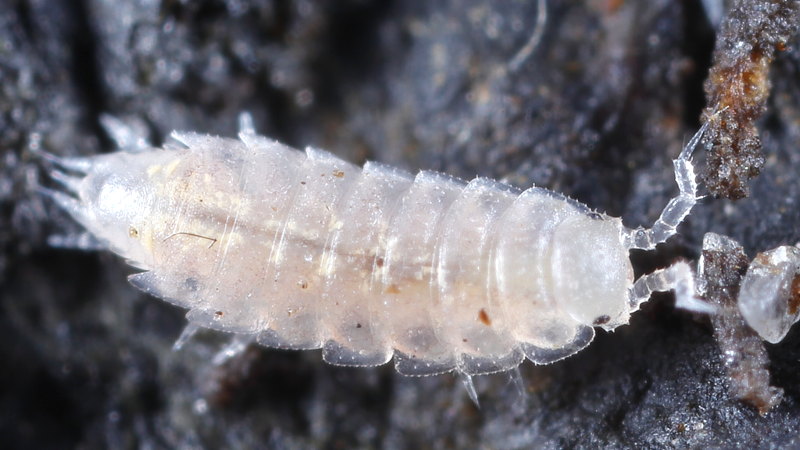
Least Pygmy Woodlouse, Trichoniscus pygmaeus
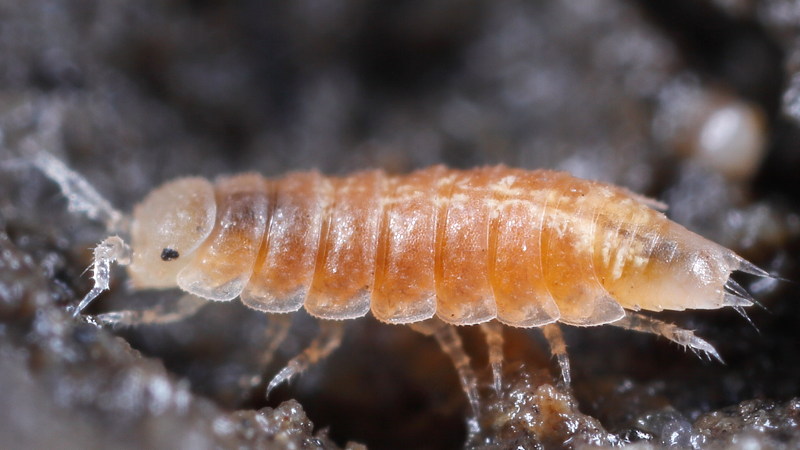
Least Pygmy Woodlouse, Trichoniscus pygmaeus
Two-spotted Waterlouse, Asellus aquaticus
Fresh waters in The Netherlands contain several species of Waterlouse. Very common is the Two-spotted Waterlouse Asellus aquaticus and it is also found in our ponds. You can recognize this species to the two light spots behind the head, the other species have there one big spot.
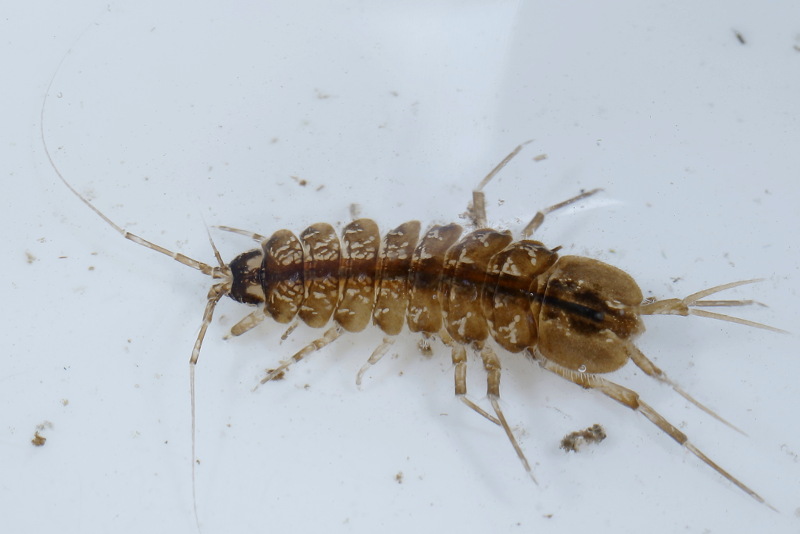
Two-spotted Waterlouse, Asellus aquaticus

Two-spotted Waterlouse, Asellus aquaticus
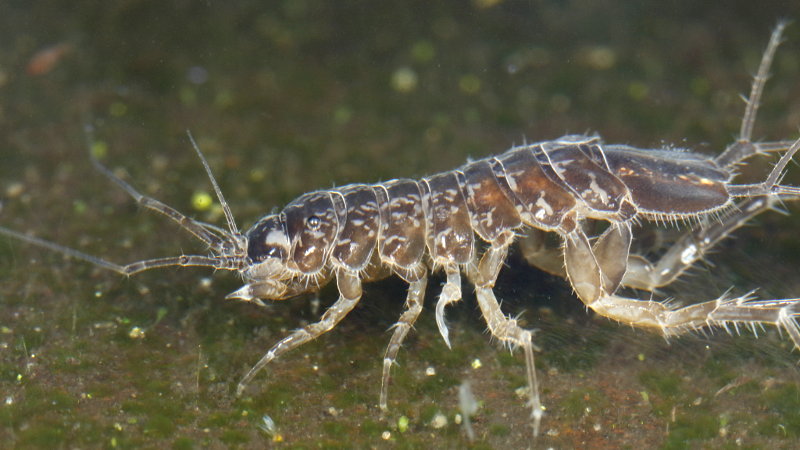
Two-spotted Waterlouse, Asellus aquaticus
Sea slater, Lekanesphaera rugicauda
Ten species of isopods occurs in the salt and brackish water in The Netherlands. De Sea slater Lekanesphaera rugicauda can be found under stones in the water. It is found both in seawater as in brackish water. This specimen I found on the banks of the Westerschelde. (Determination: Matty Berg)
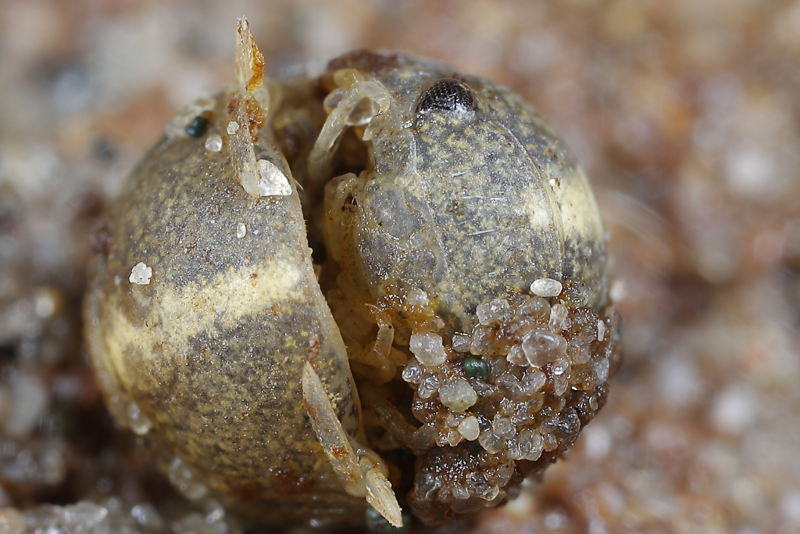
Sea slater, Lekanesphaera rugicauda
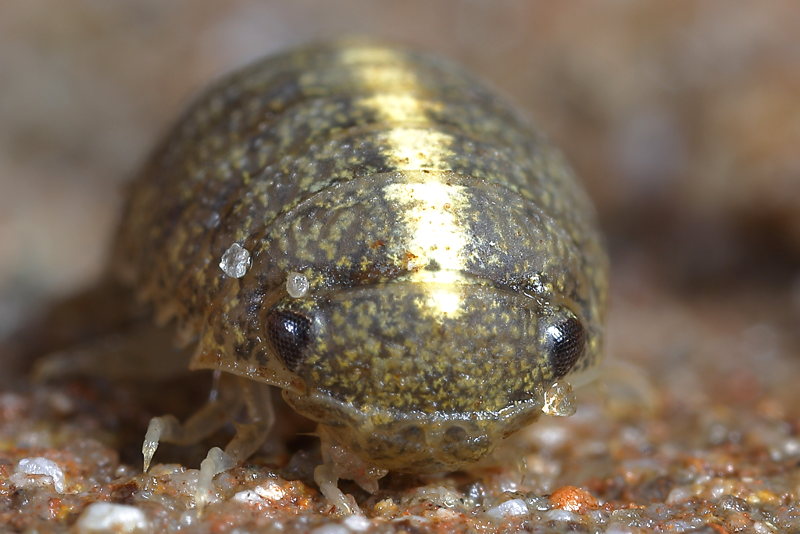
Sea slater, Lekanesphaera rugicauda
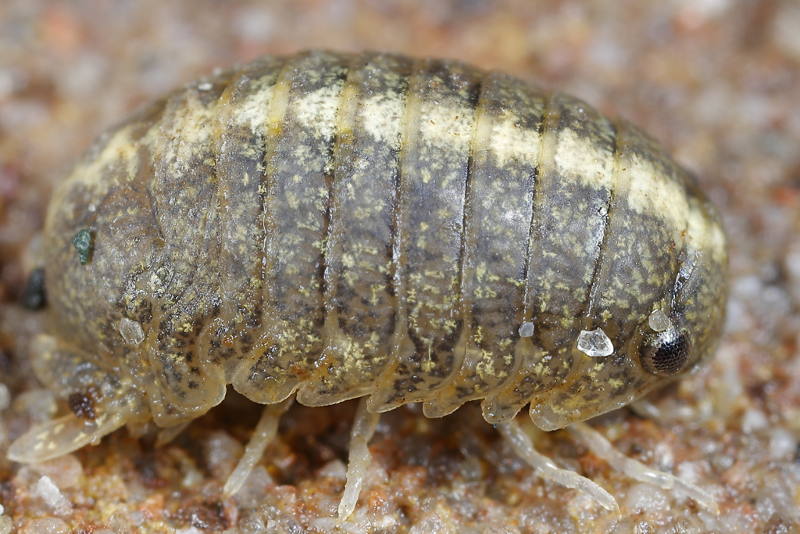
Sea slater, Lekanesphaera rugicauda

Sea slater, Lekanesphaera rugicauda
Thanks:
I would like to thank Arp Kruithof and Matty Berg for the finding of animals and sharing knowledge of the isopoda.
literature:
- Berg, M.P. 1997. Naamlijst van de Nederlandse landpissebedden (Crustacea: Isopoda: Oniscidea) — Nederlandse Faunistische Mededelingen, 7: 31-34.
- Berg, M.P. & Wijnhoven, H. 1997. Landpissebedden, een tabel voor de landpissebedden (Crustacea: Oniscidea) van Nederland en België — KNNV Uitgeverij. Wetenschappelijke Mededeling 221
- Berg, M.P., Duinen, J.J. van. 2018. Landpissebedden, een tabel voor de landpissebedden. Jeugdbondsuitgeverij, 's Graveland